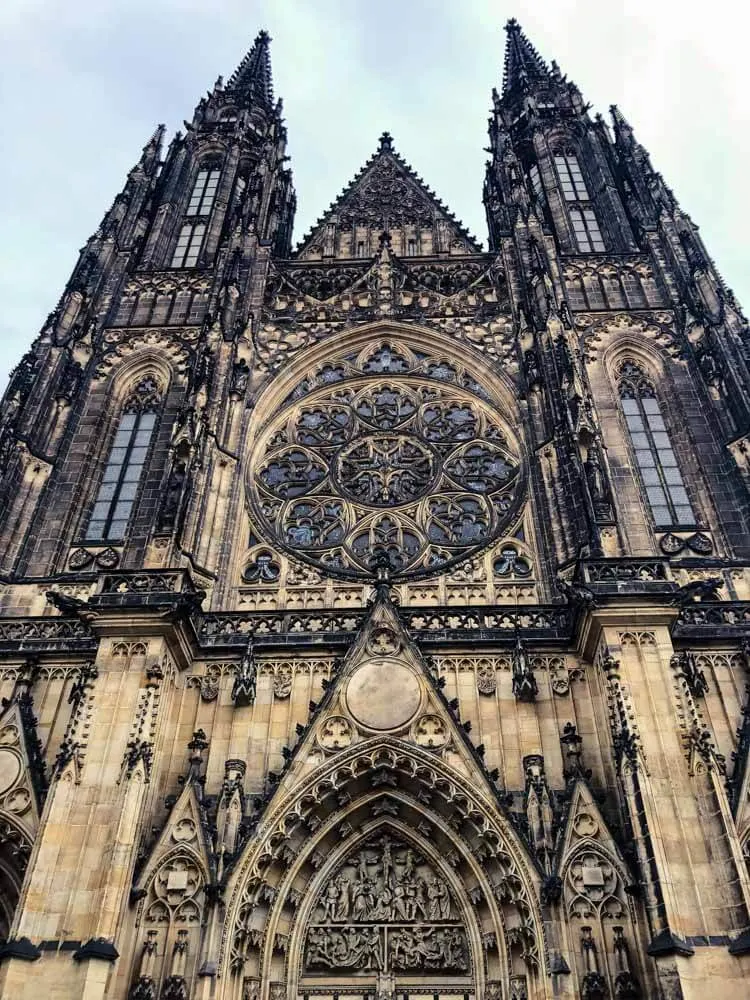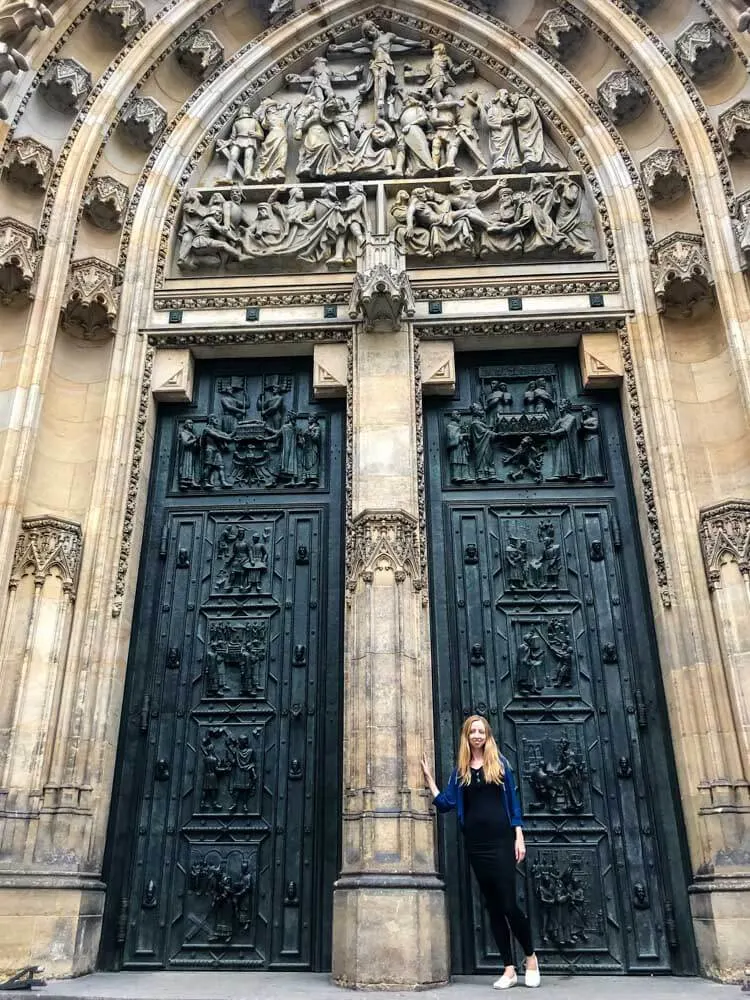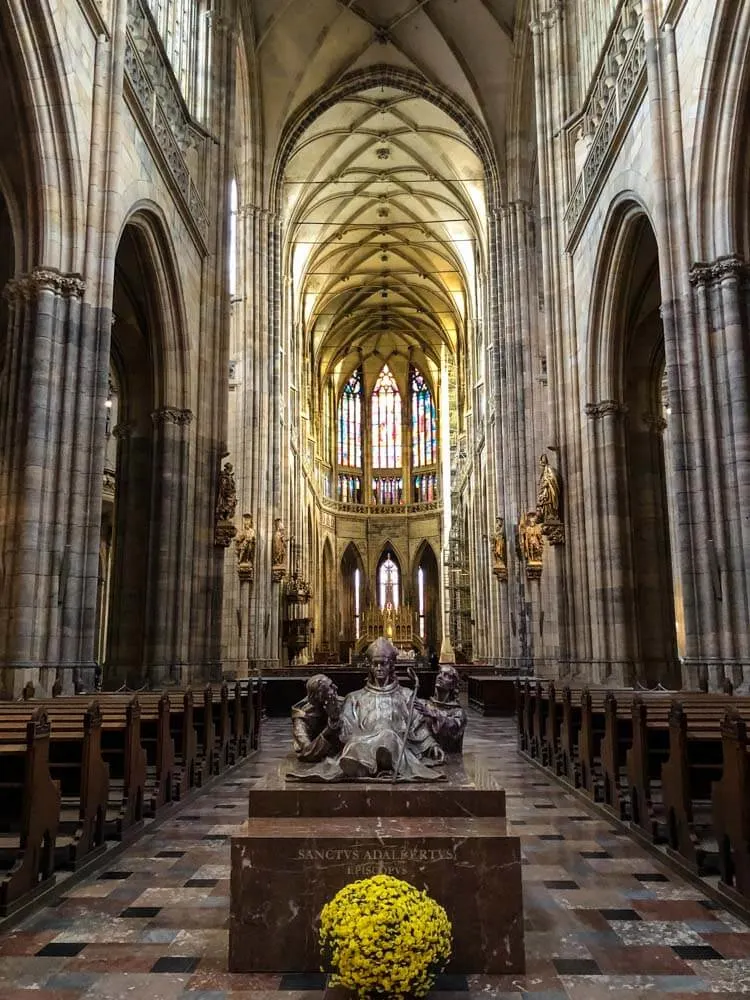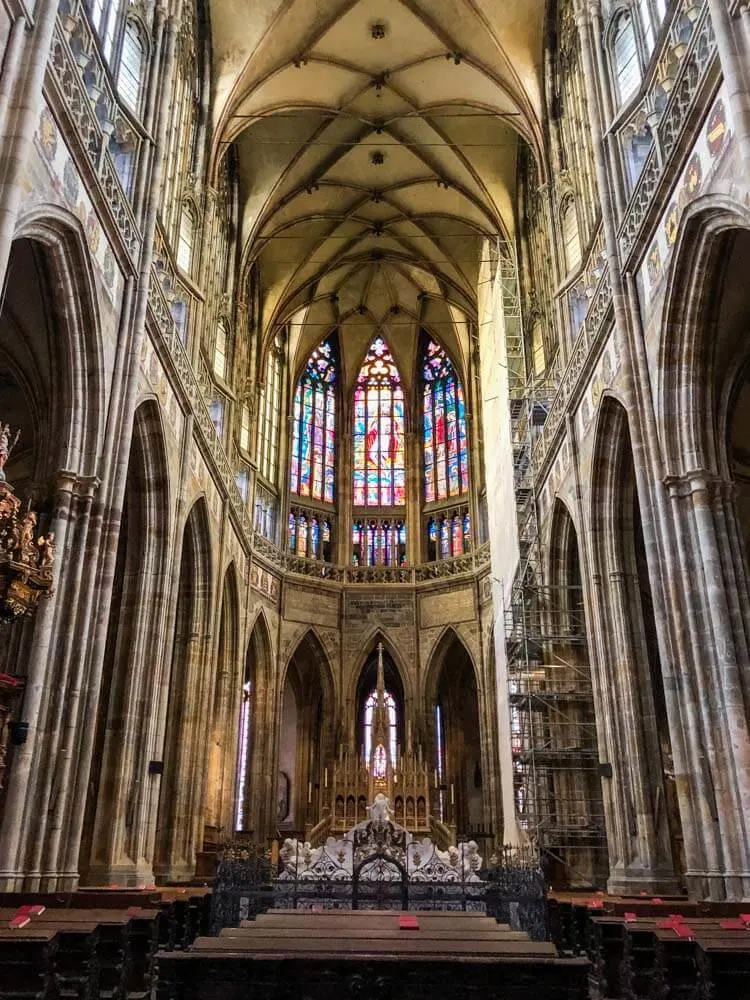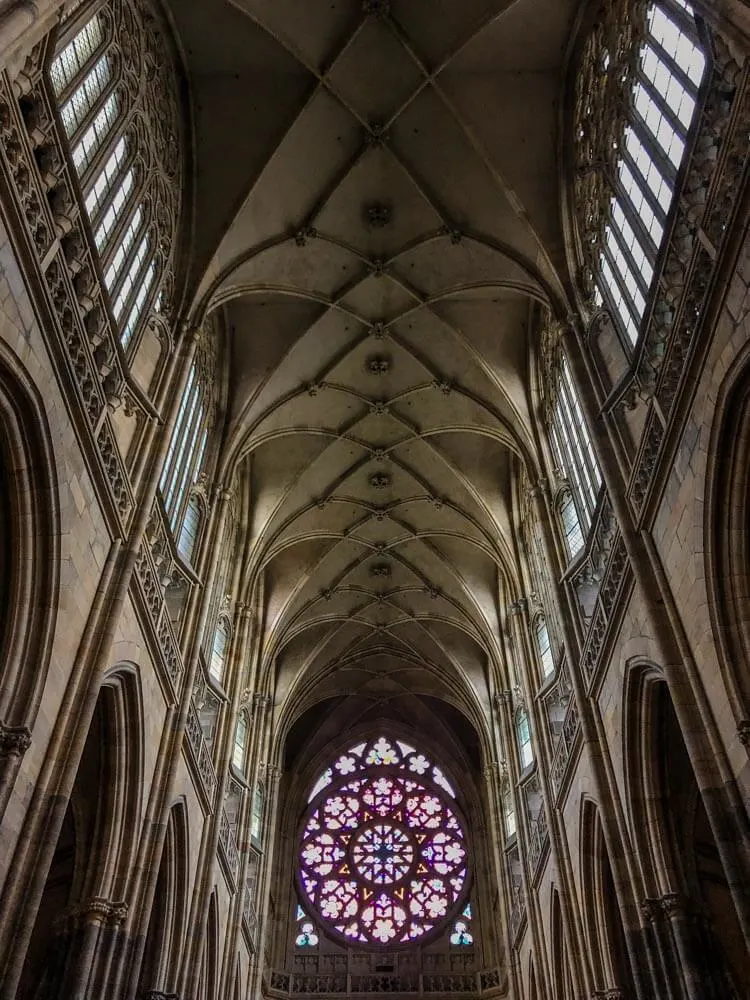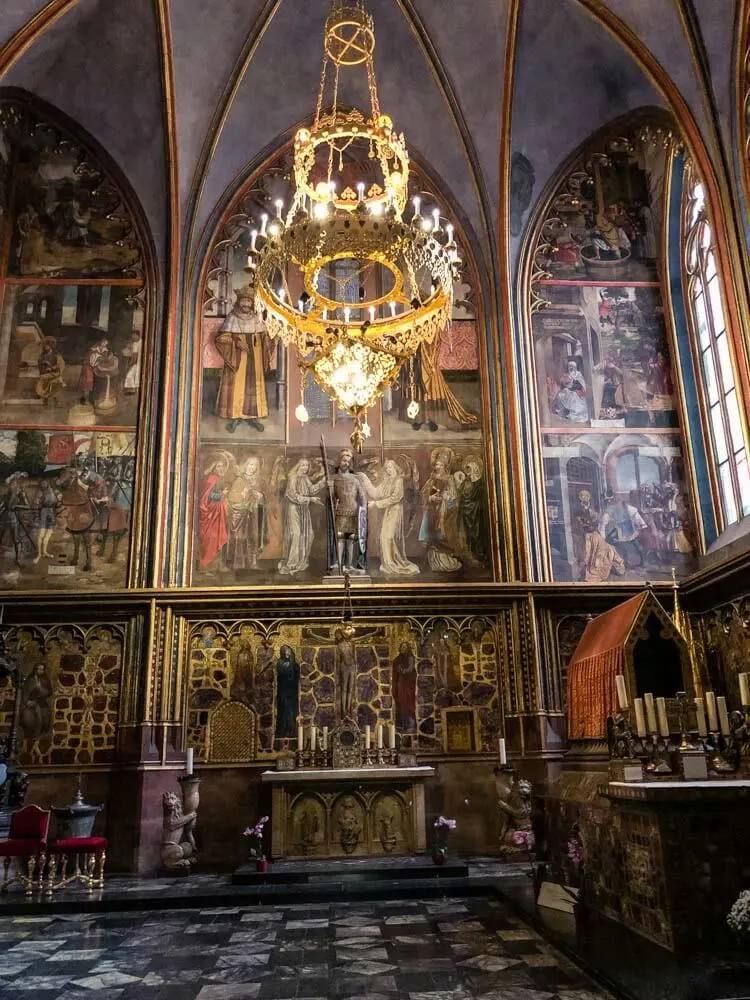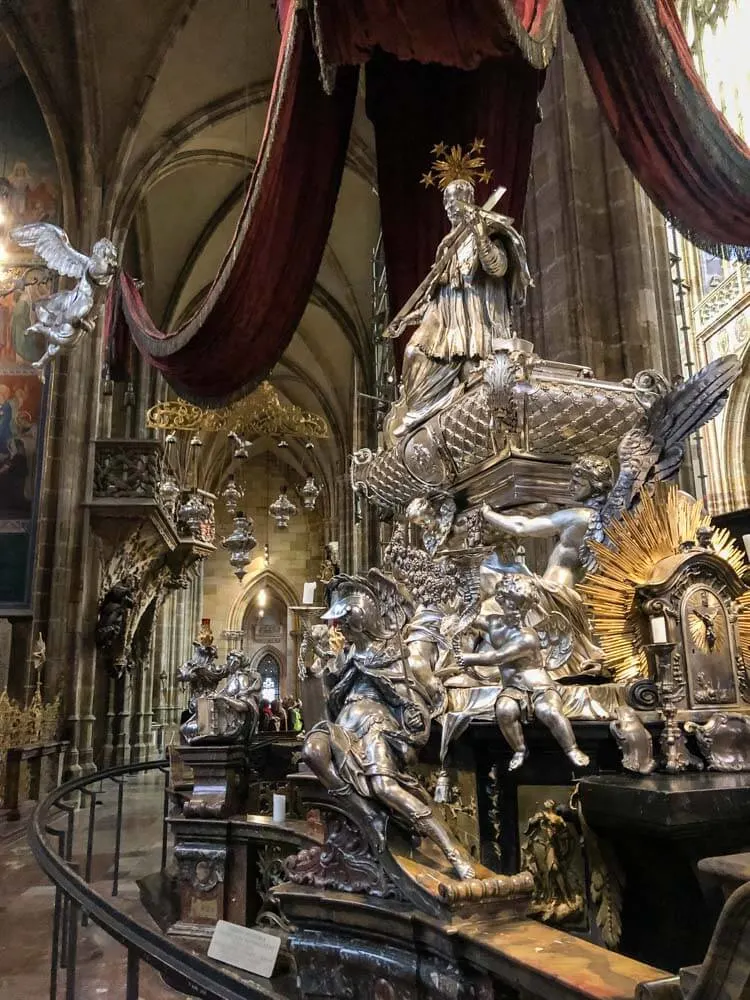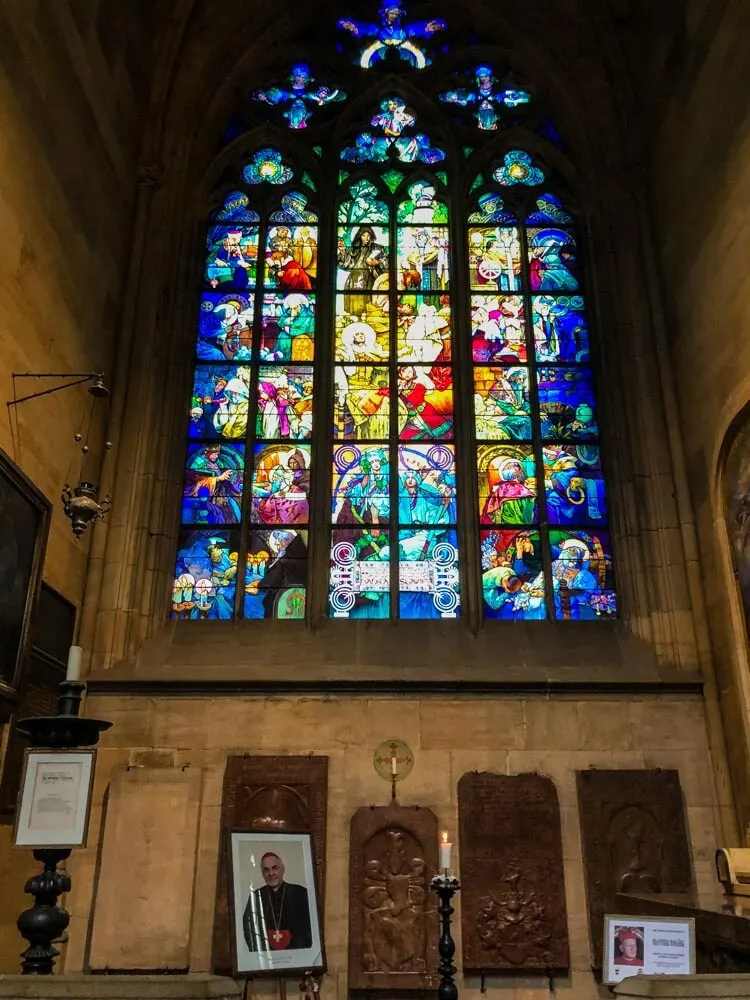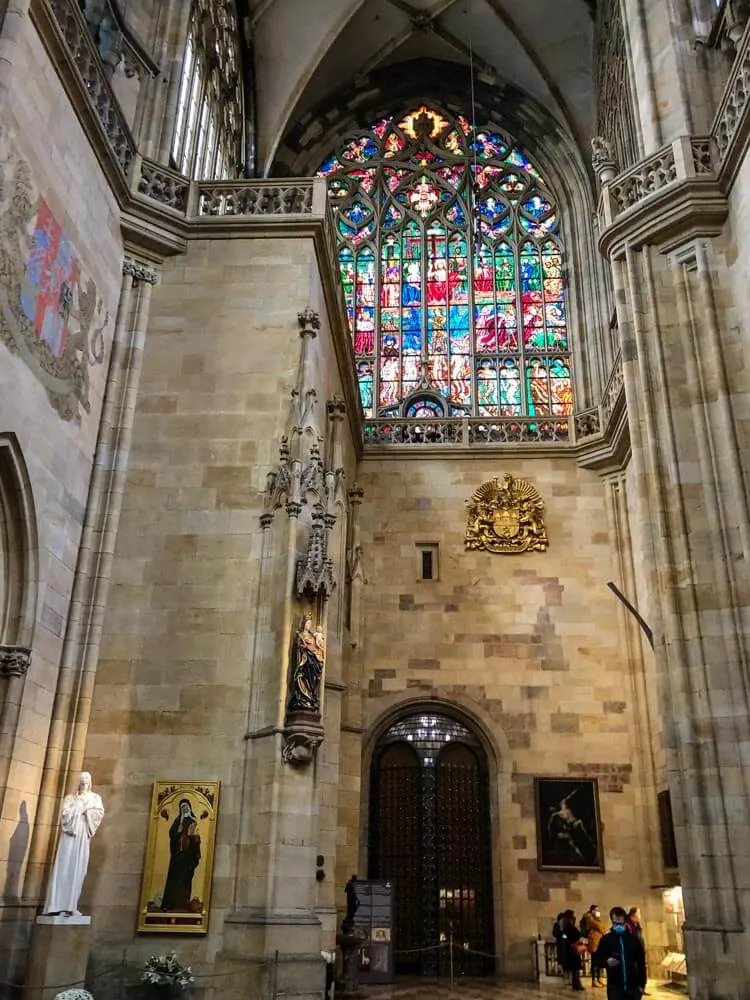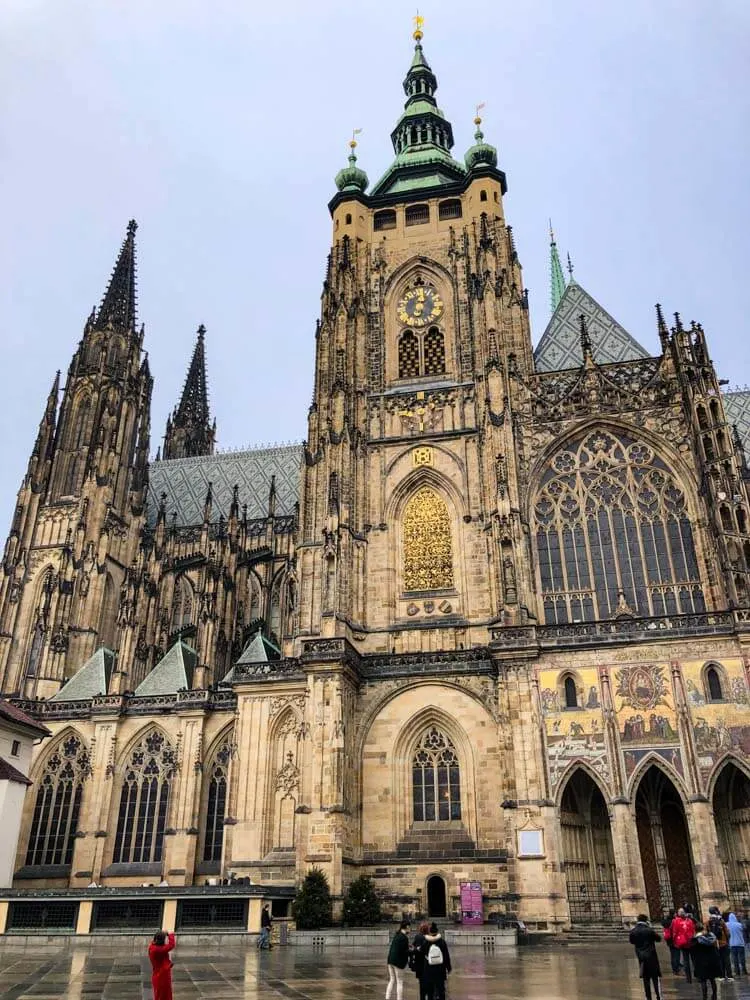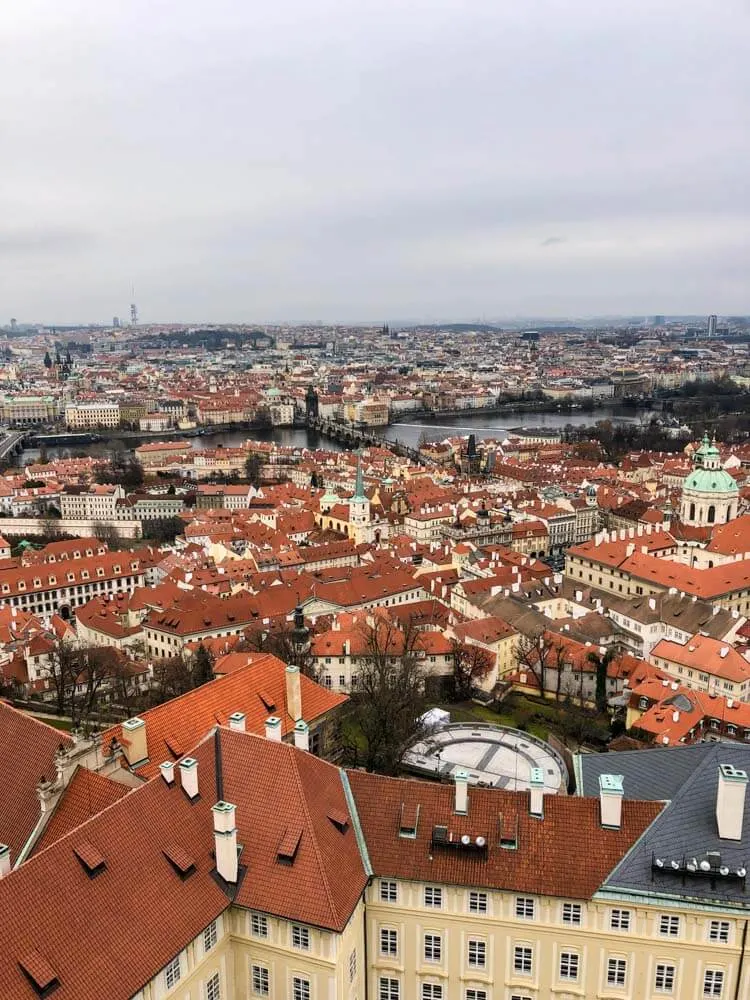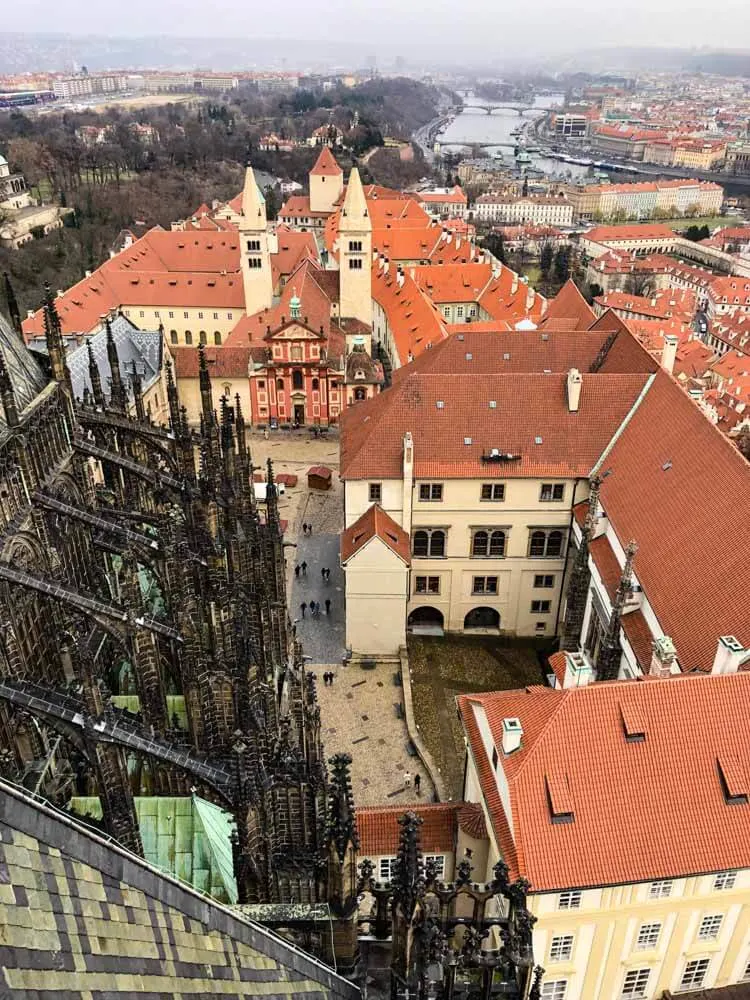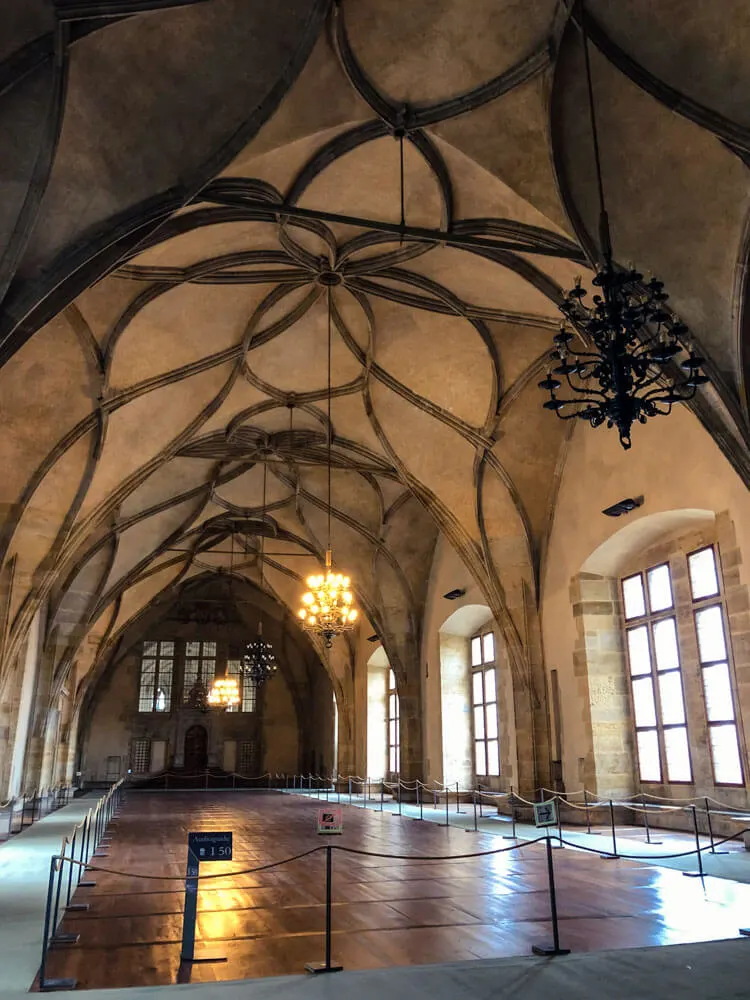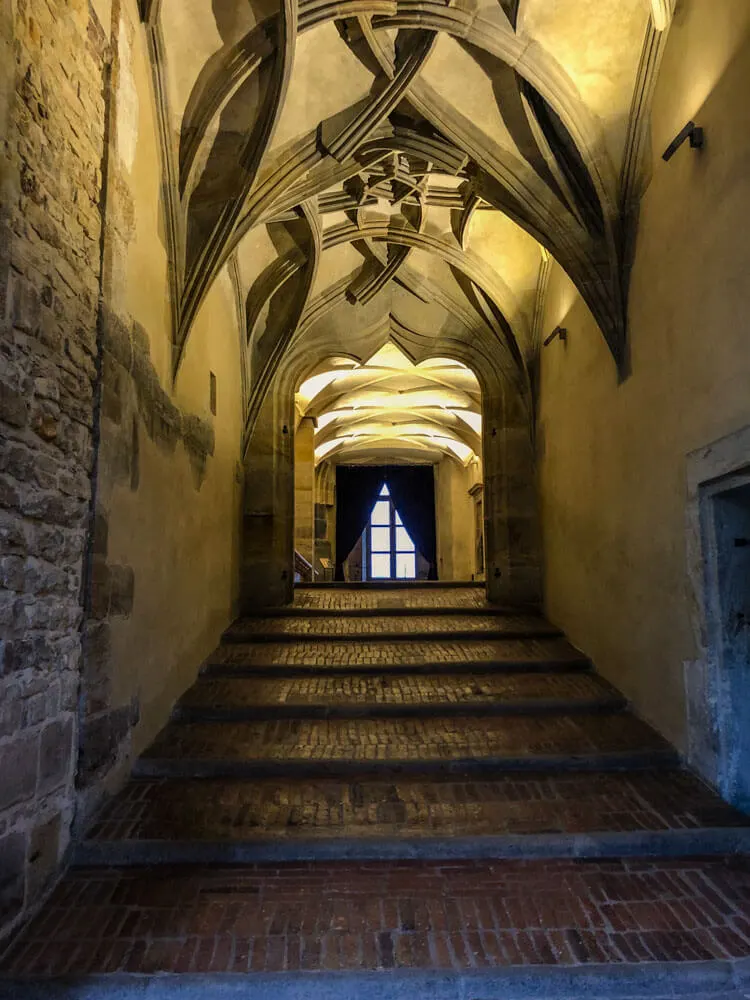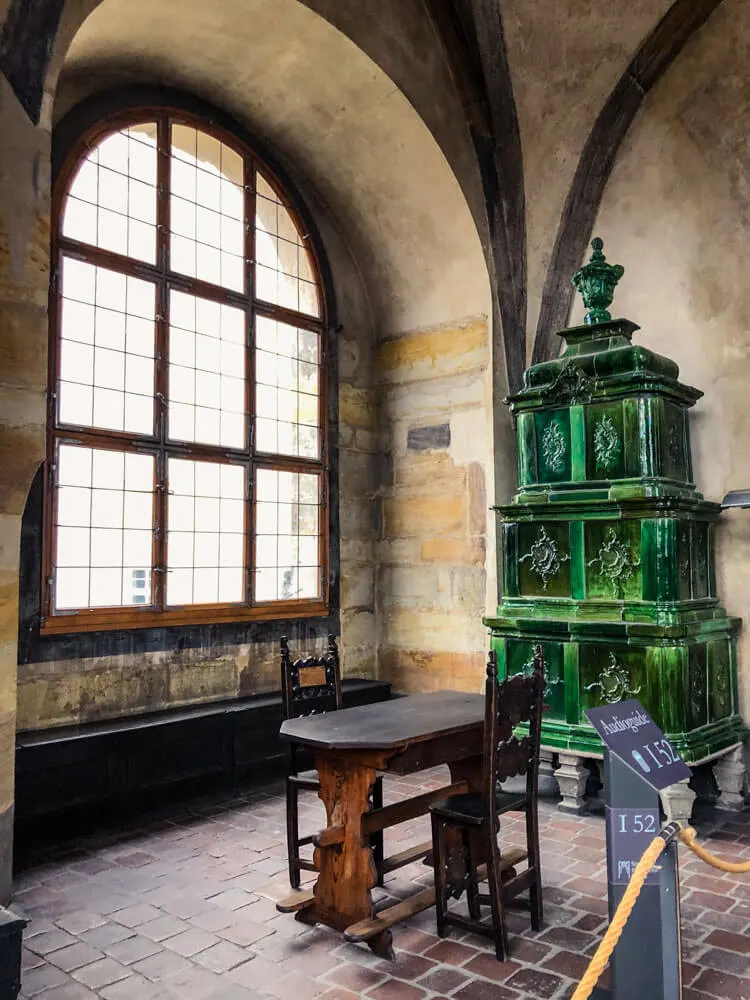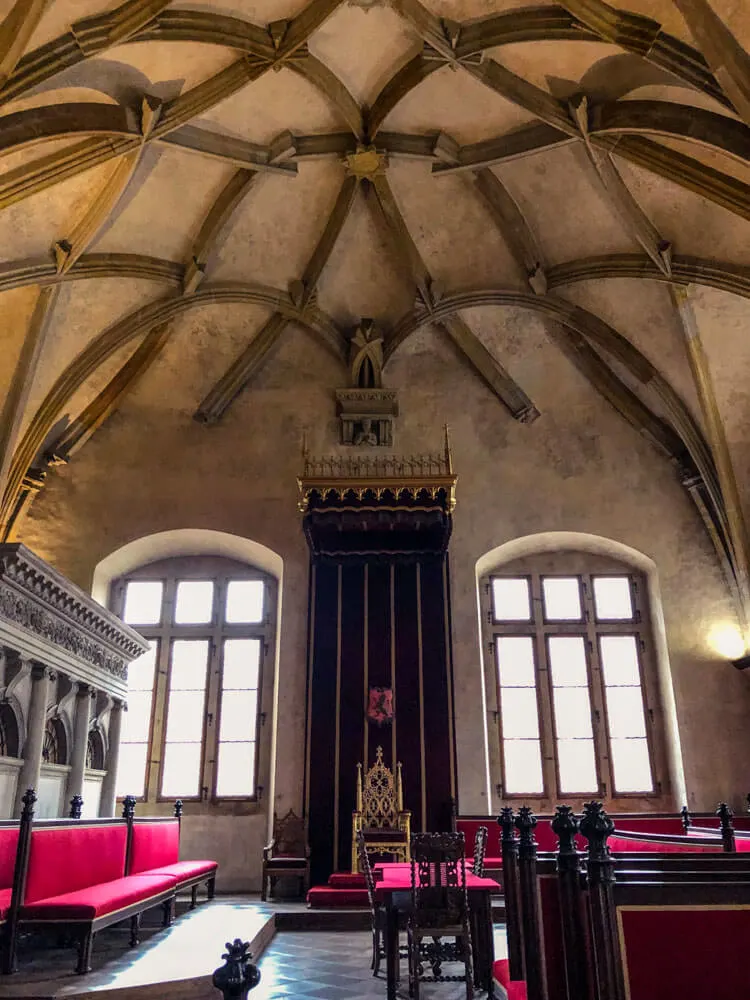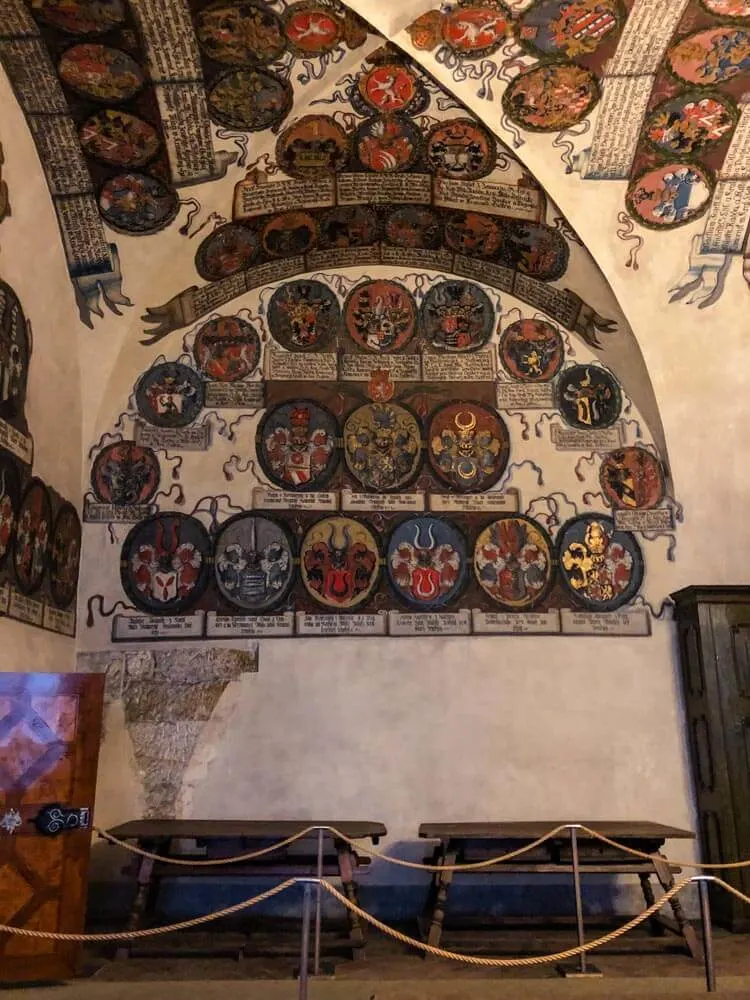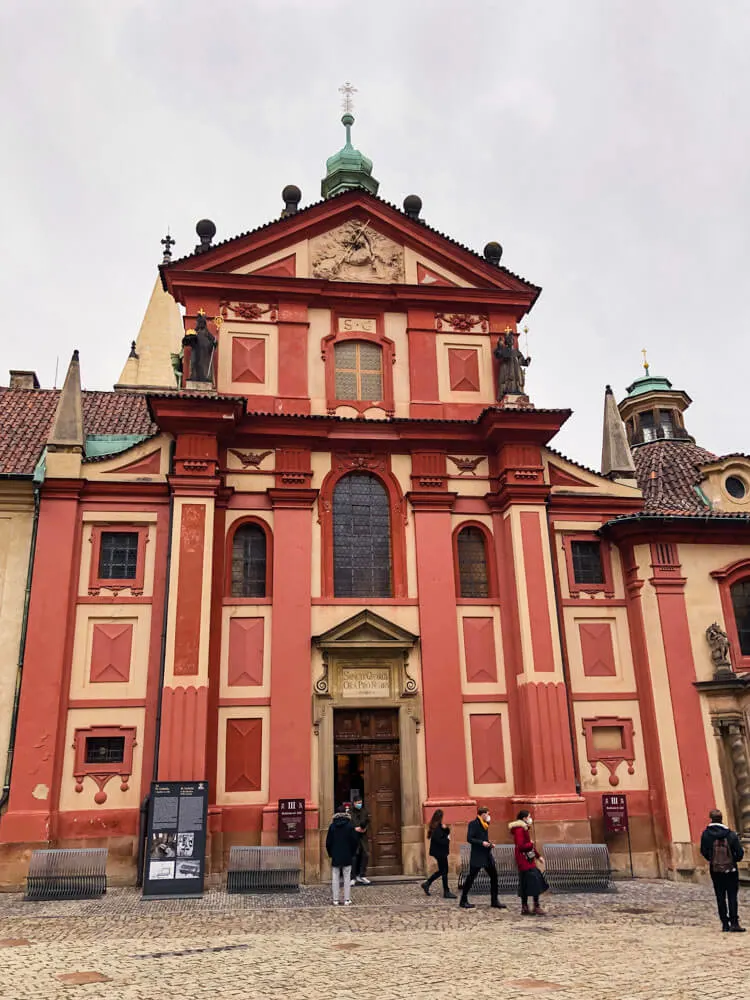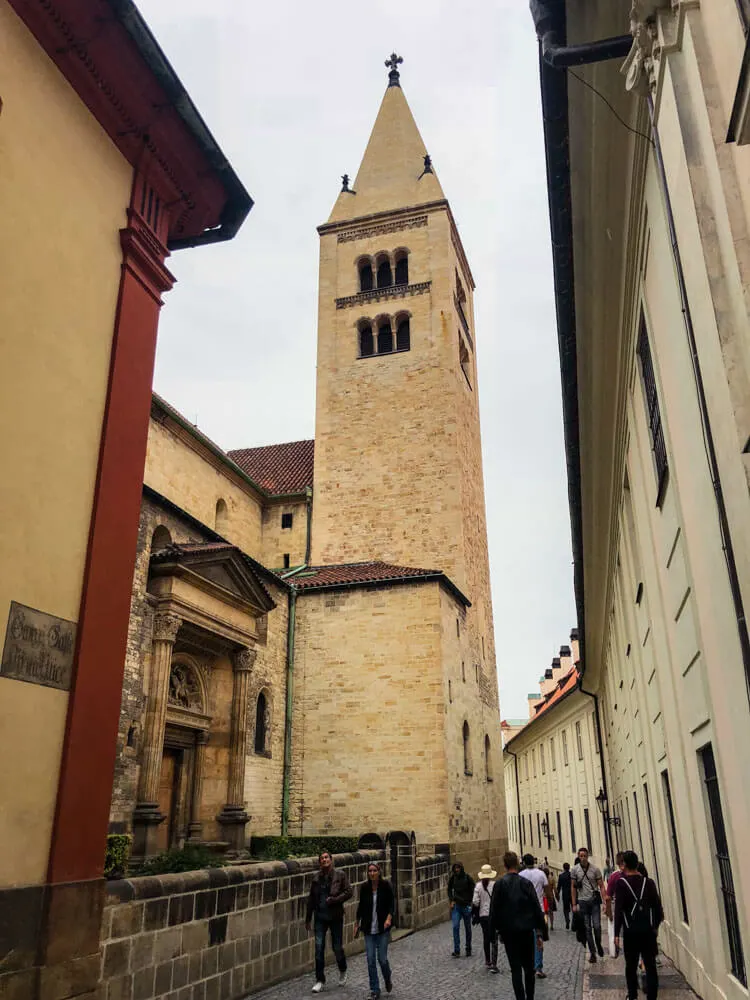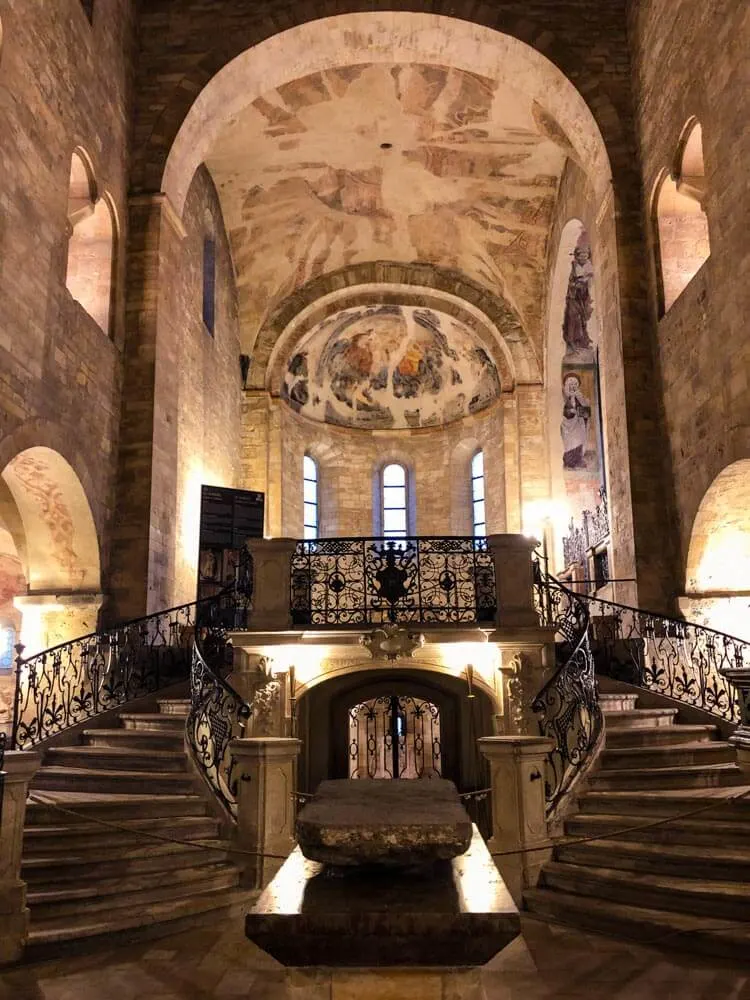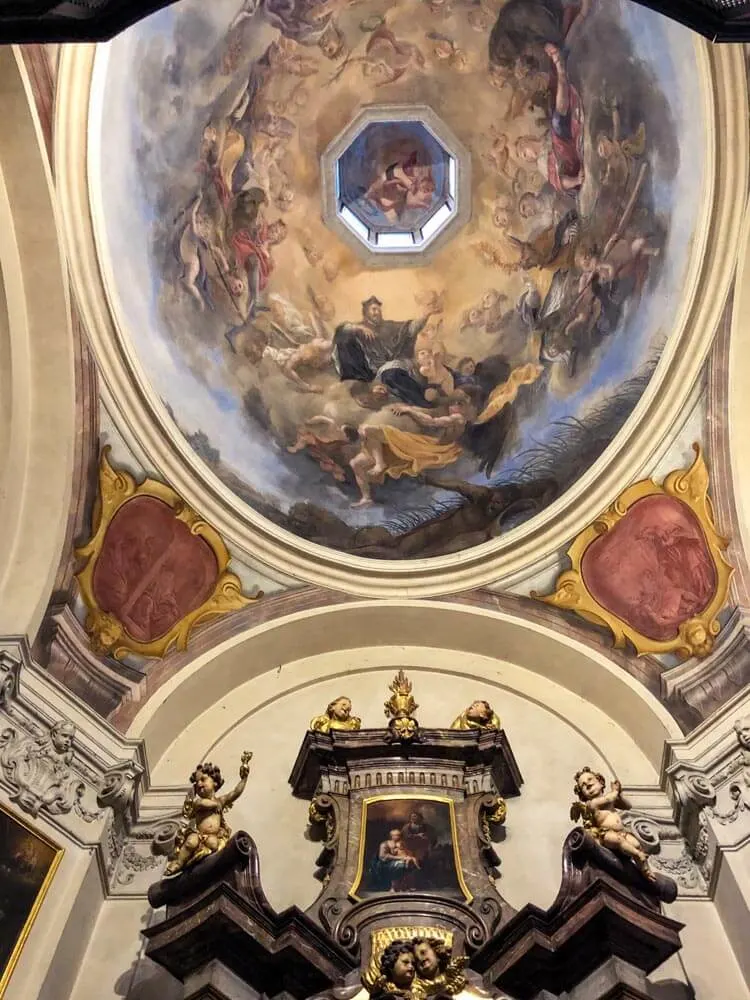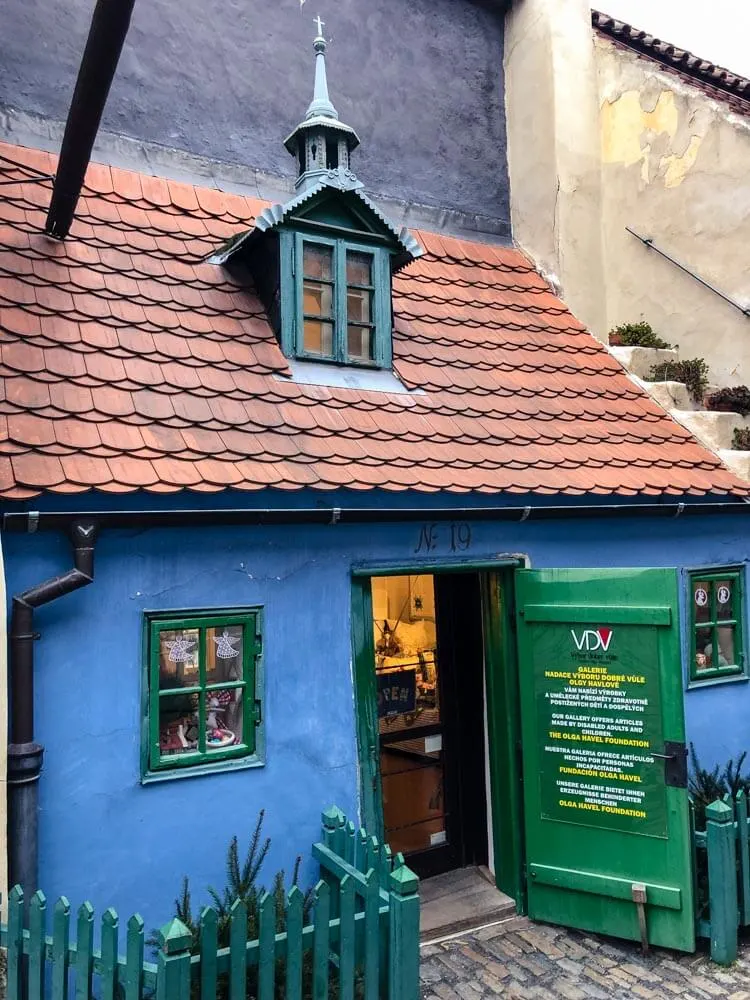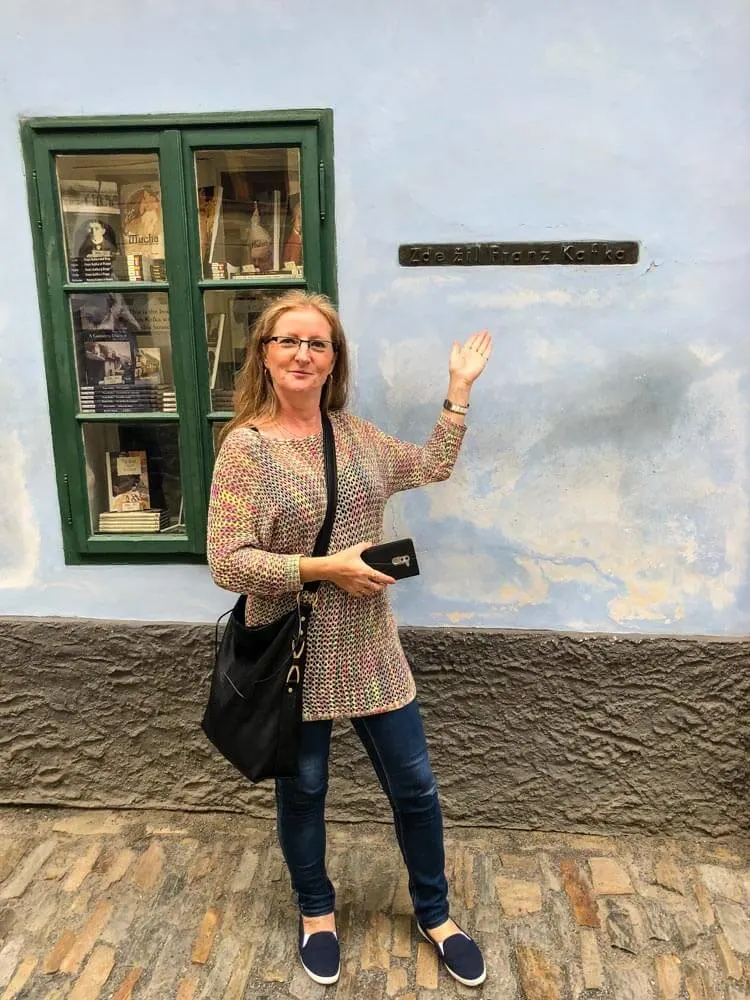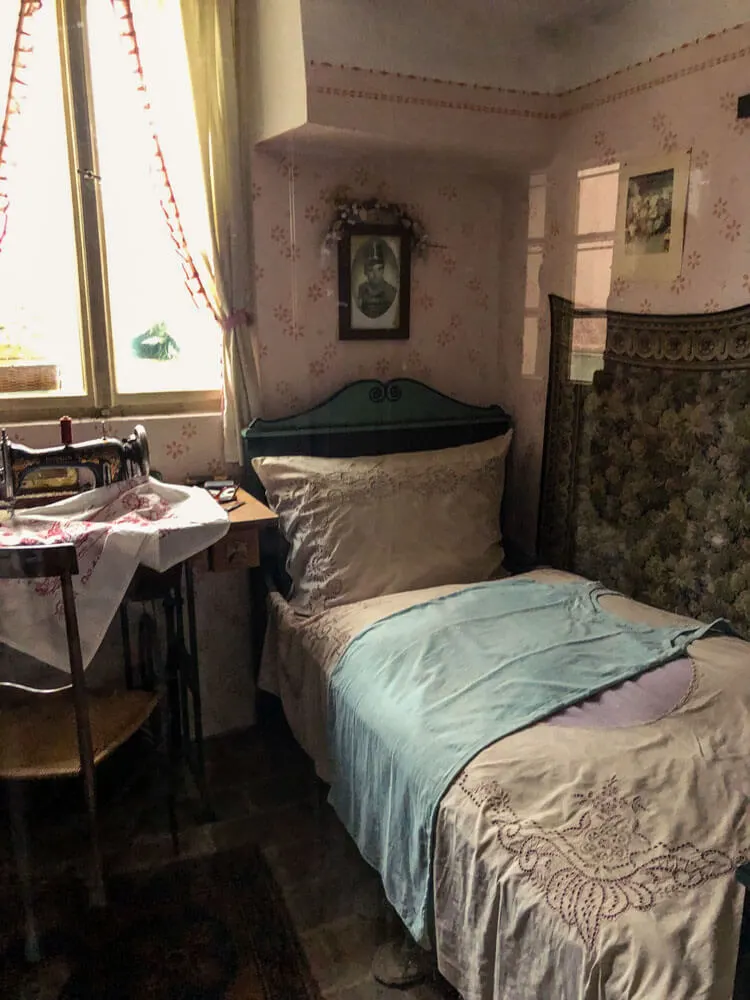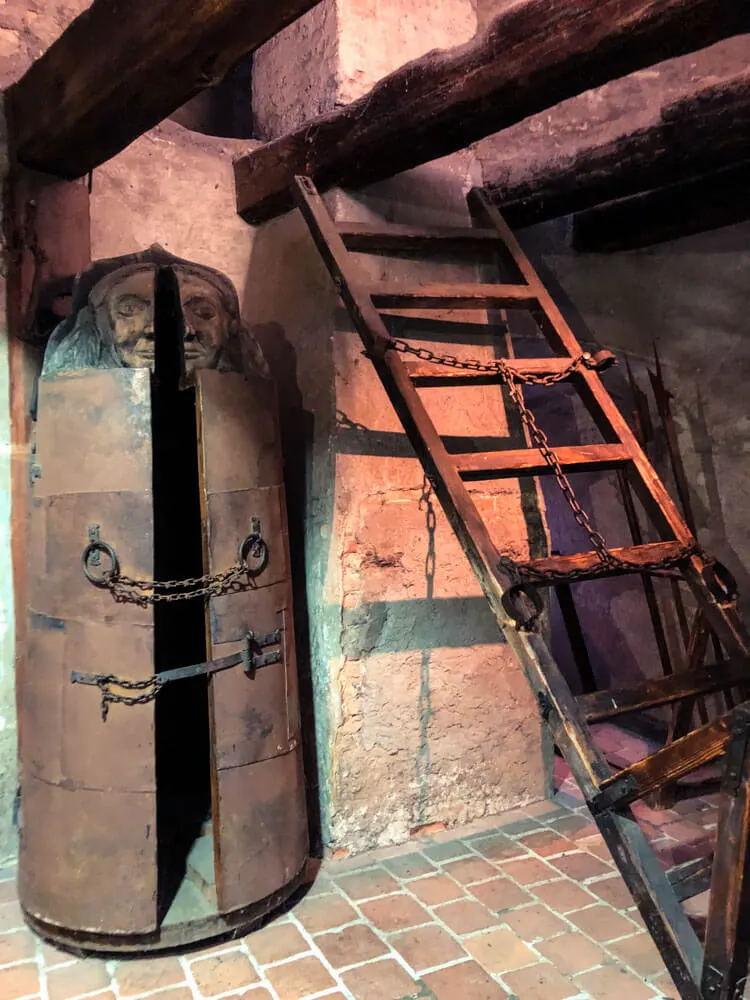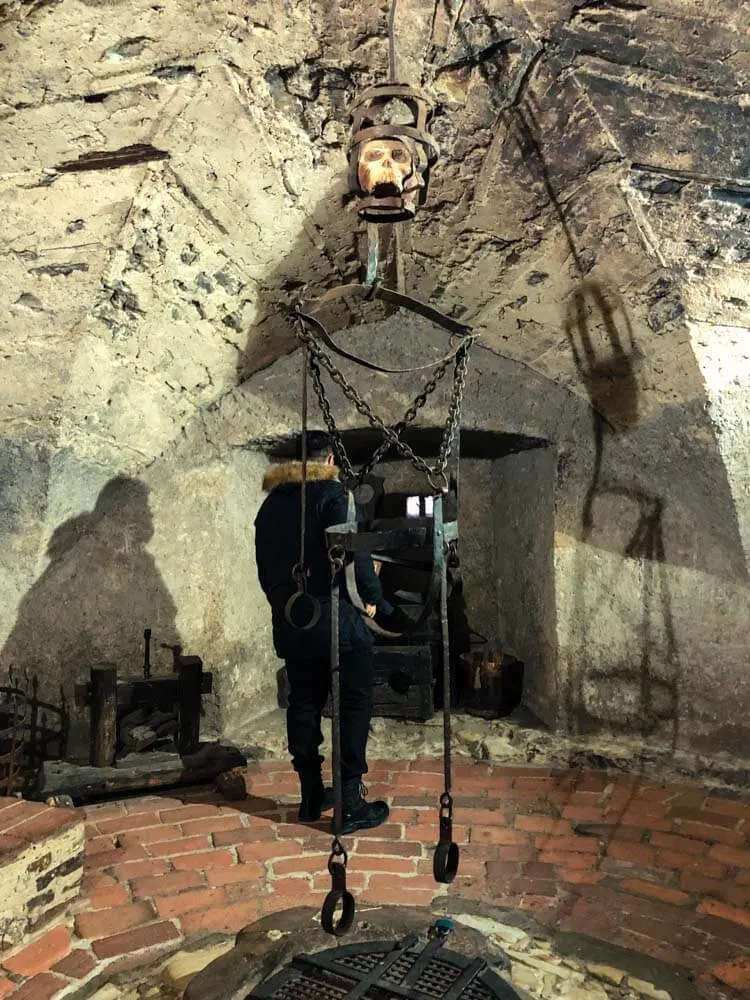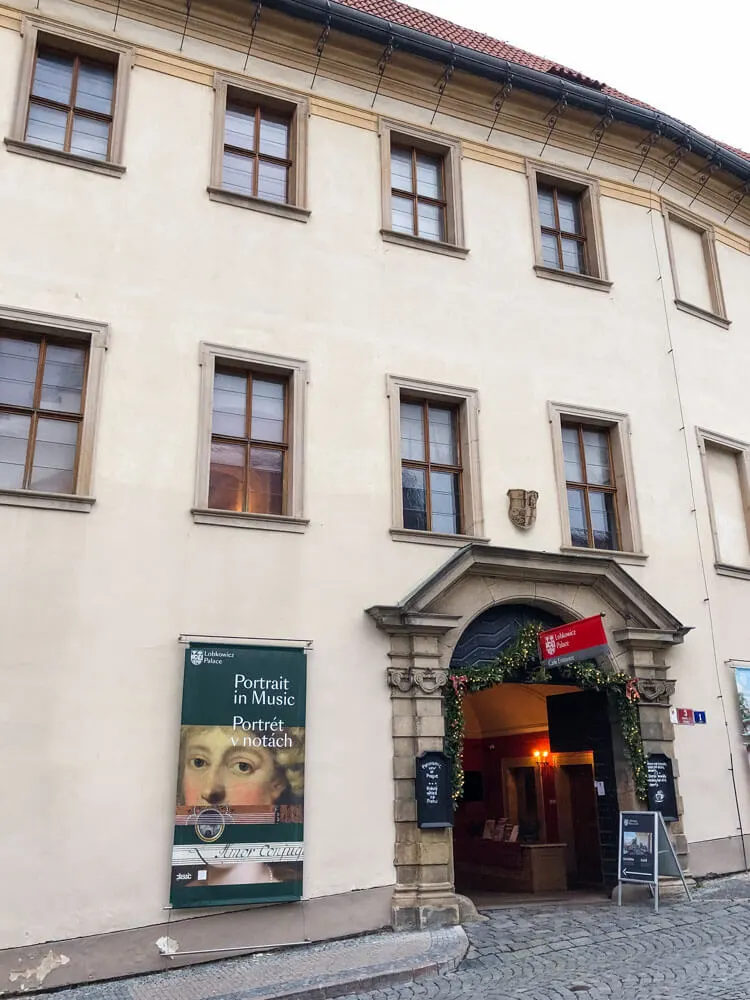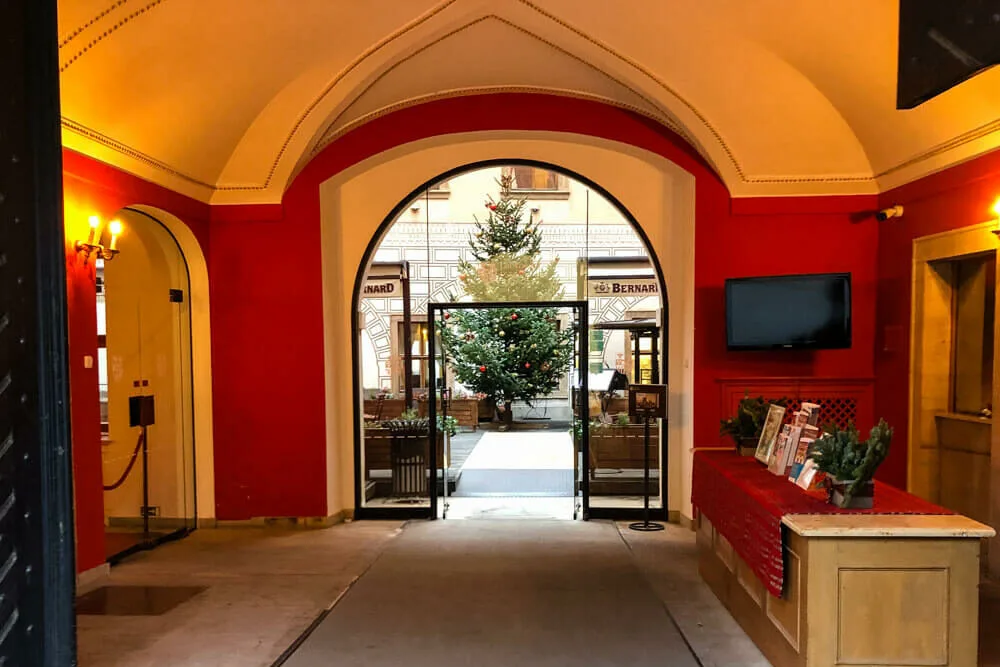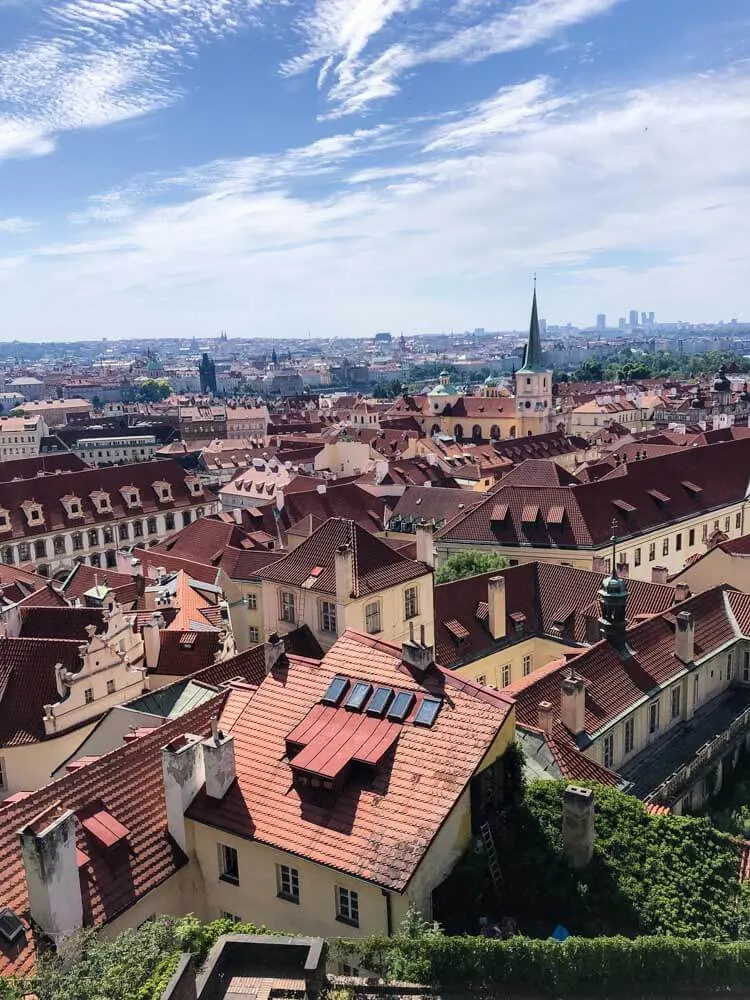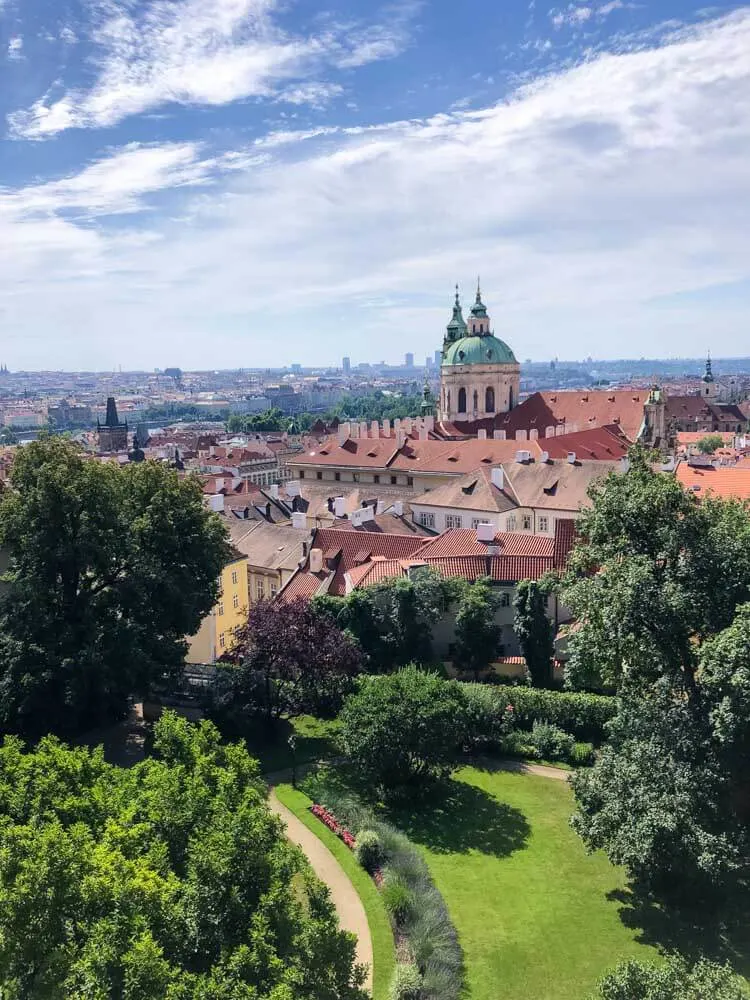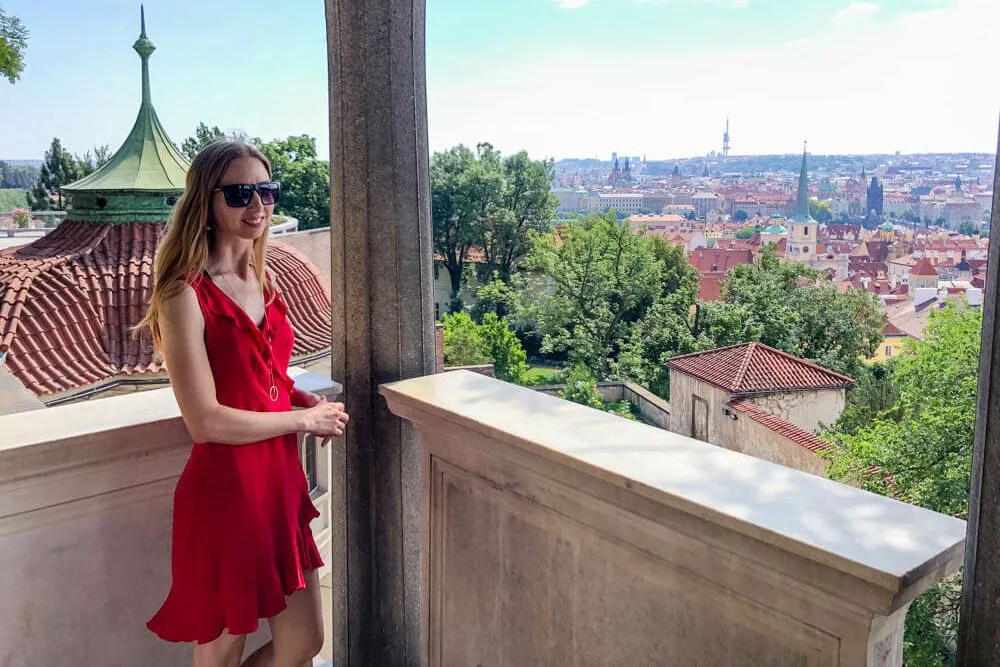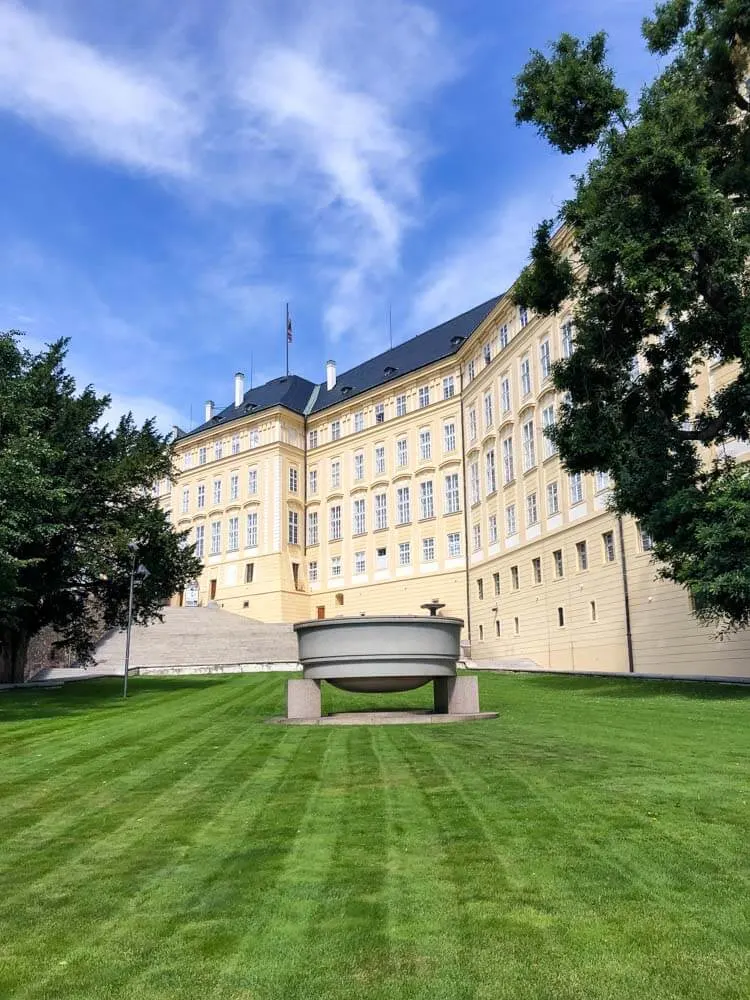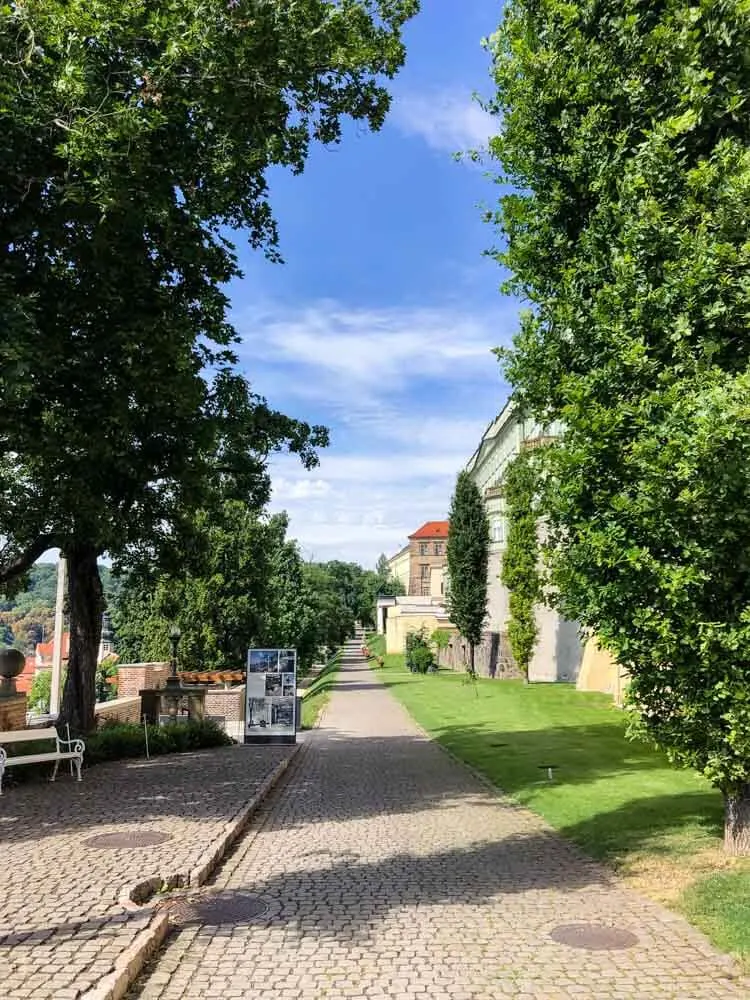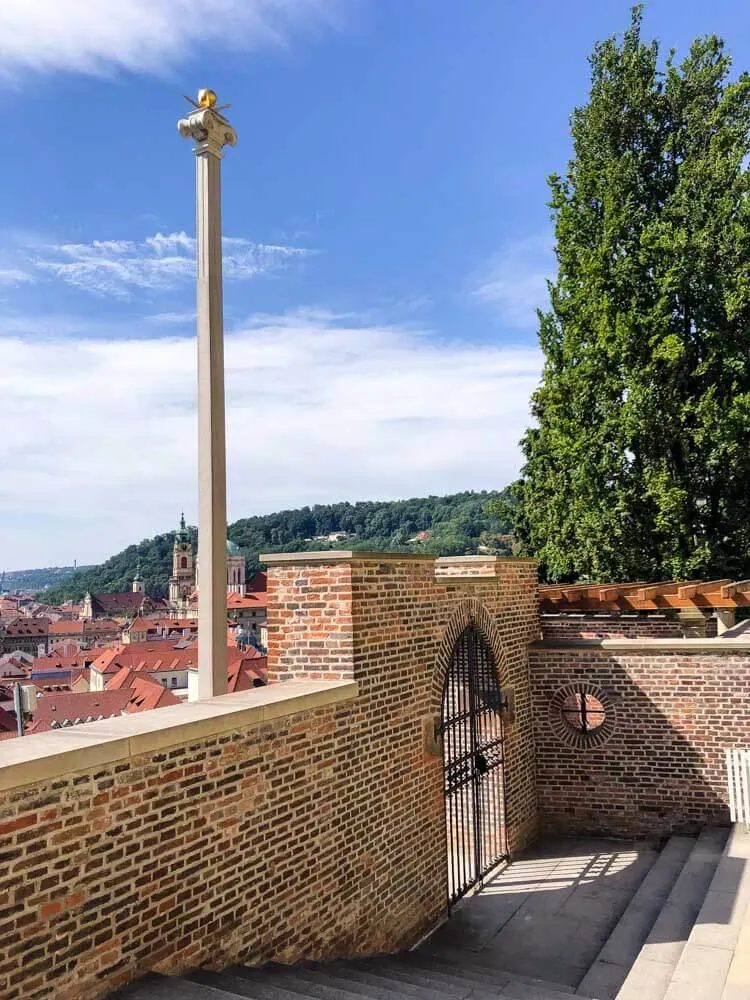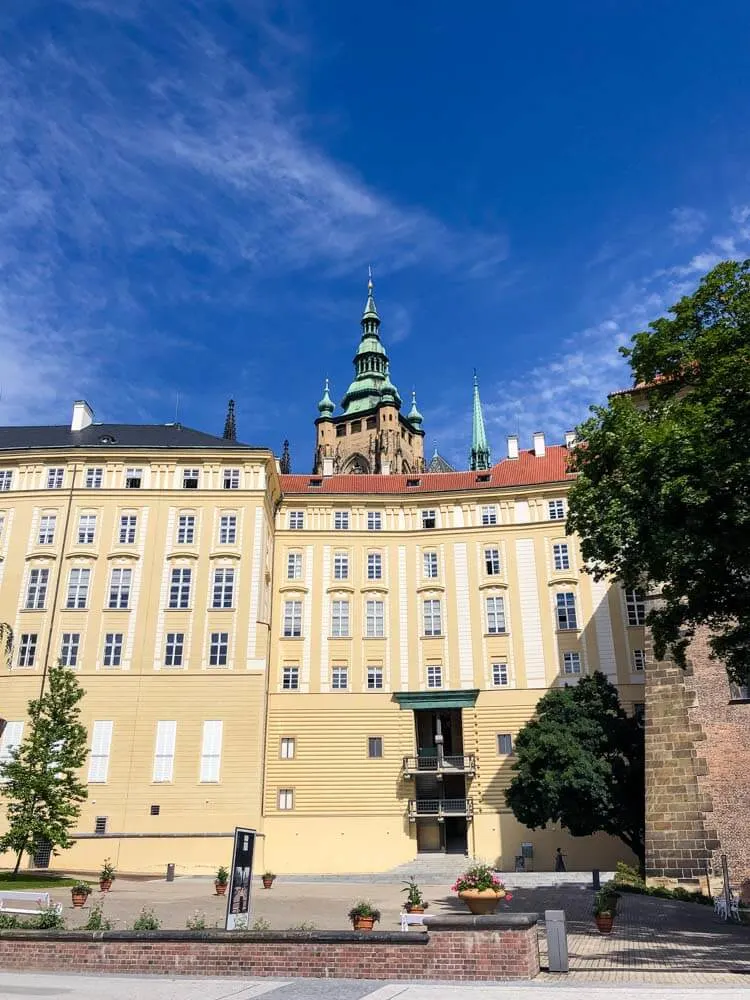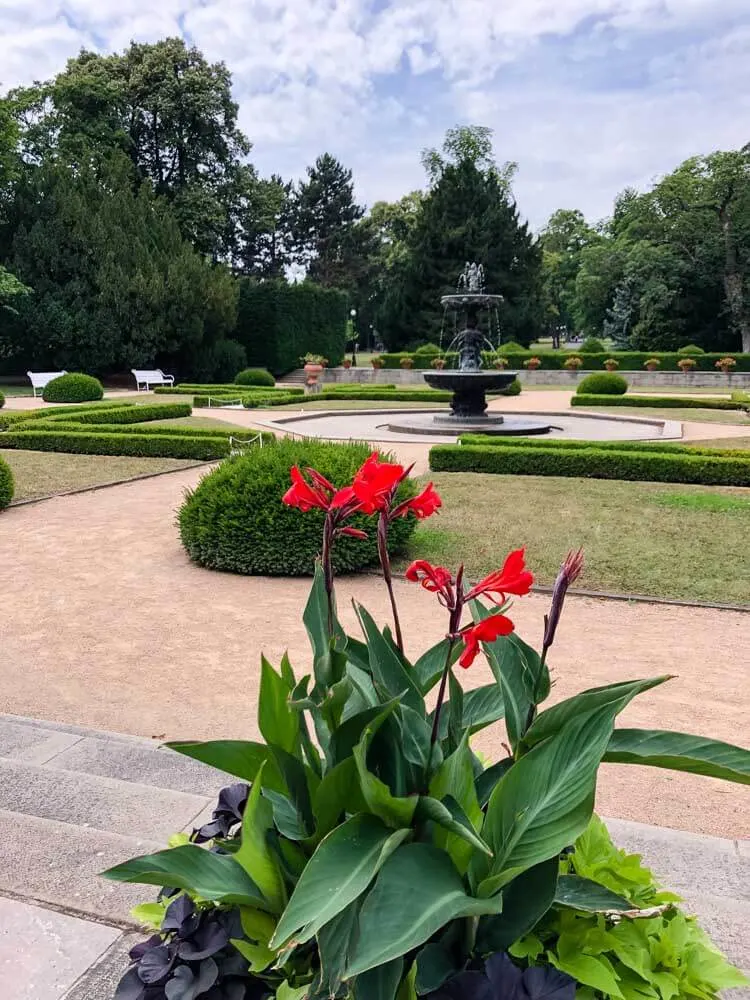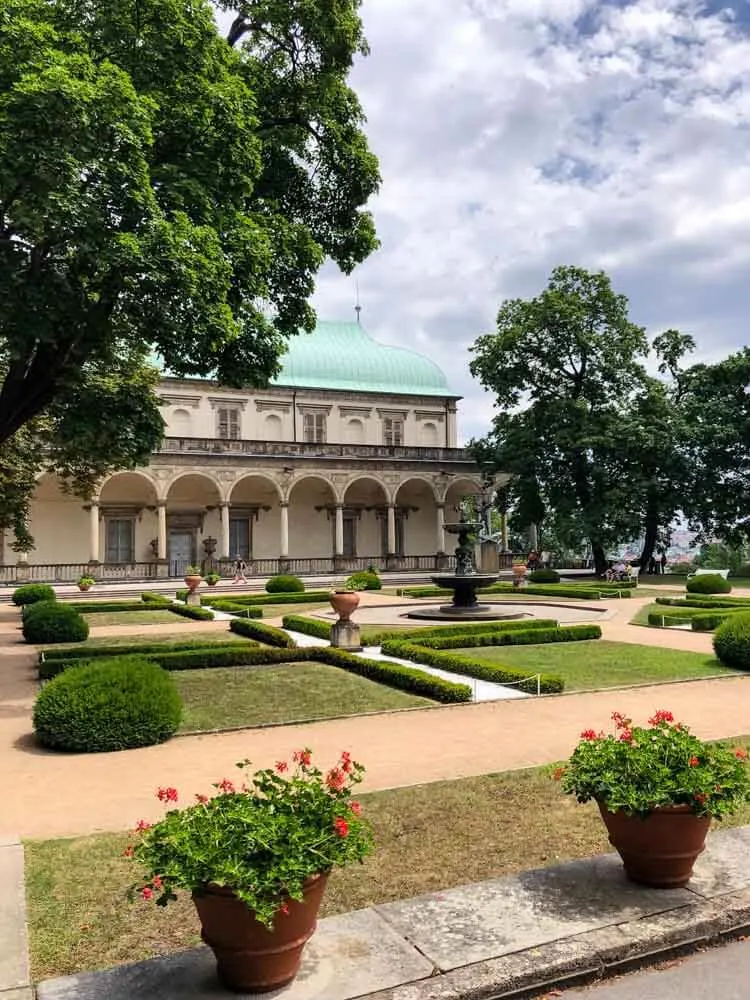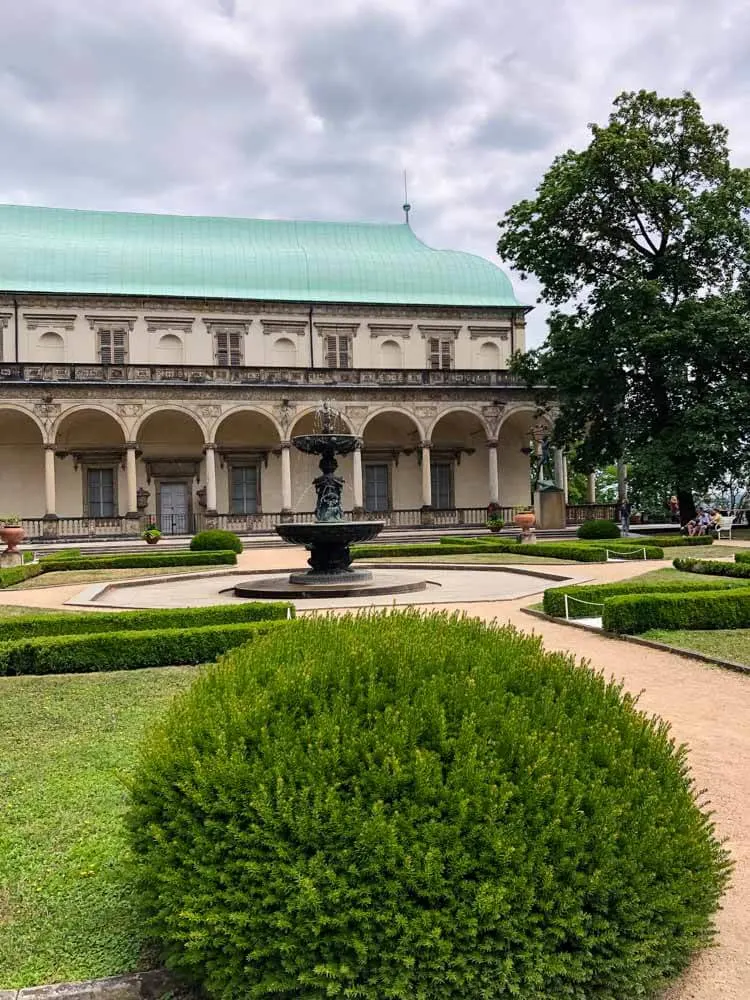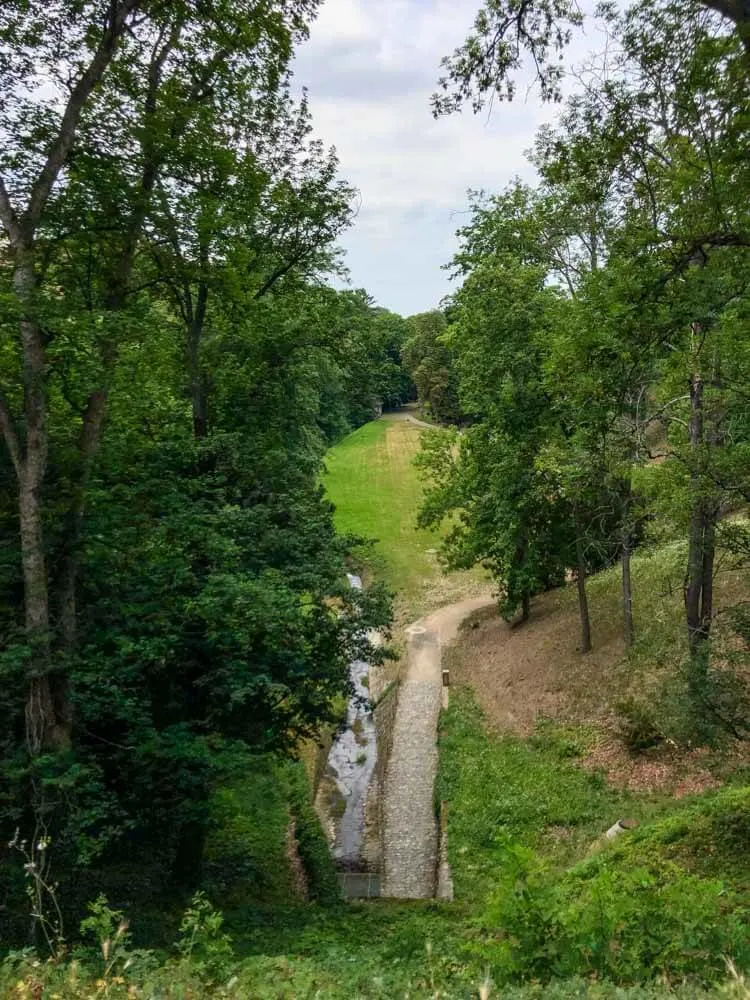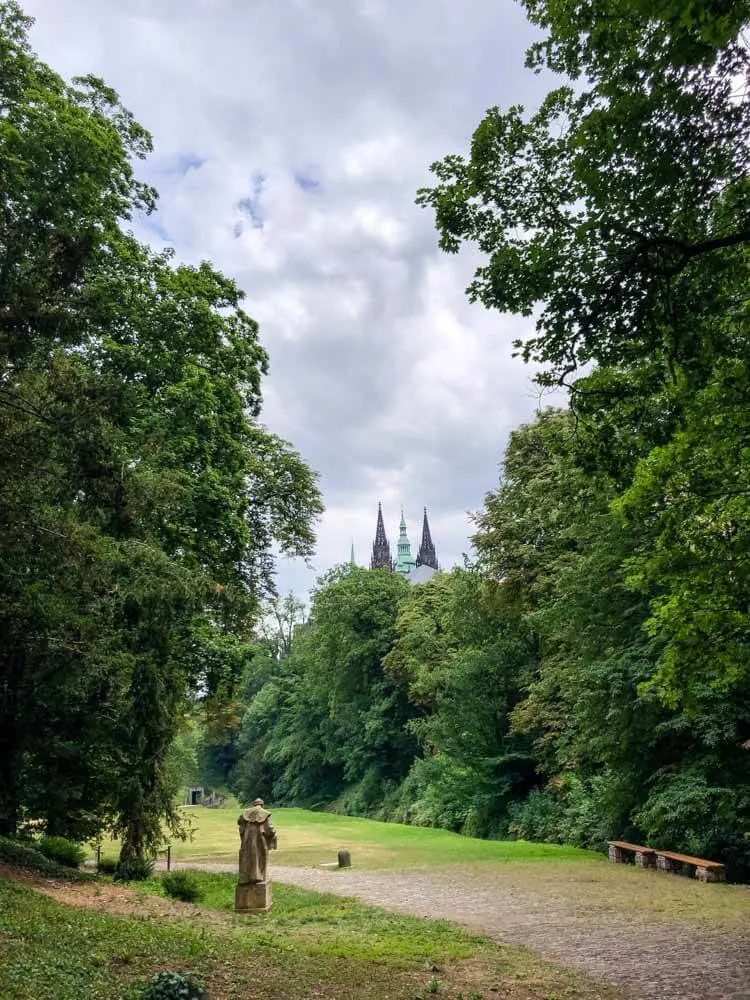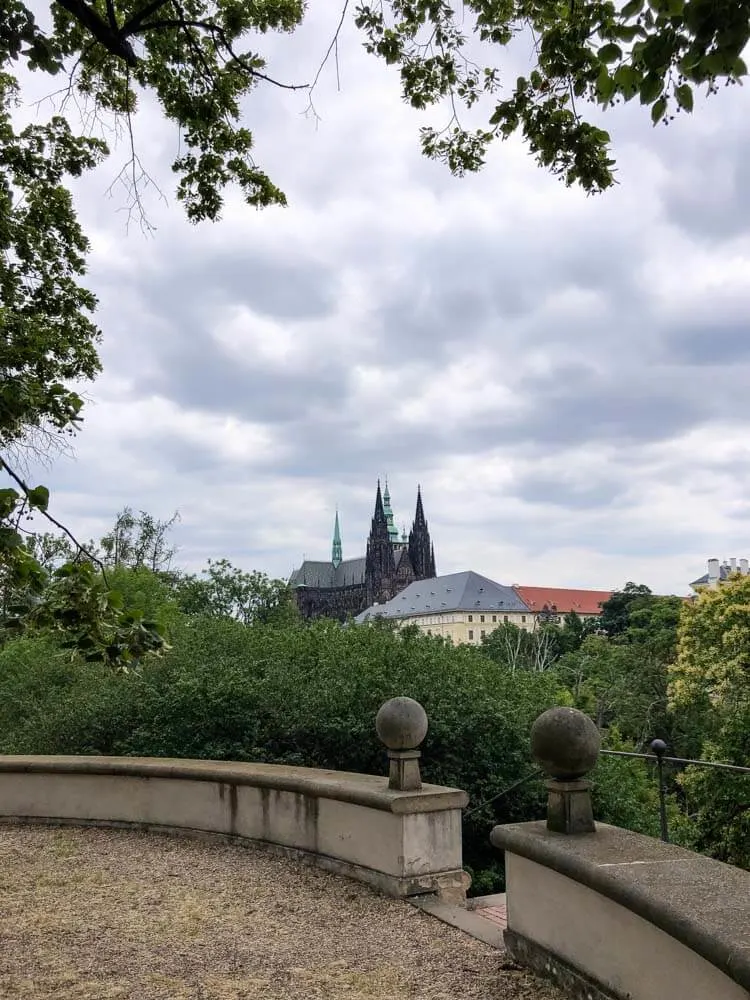Table of Contents
Prague Castle is undoubtedly THE most famous Czech castle. It helps it’s UNESCO-listed and is claimed and confirmed (by the Guinness World Records) to be the largest castle in the world.
As is often the case when you’re a local somewhere, you tend to omit the main landmarks and go see them just when out-of-town (or, more fittingly, out-of-country) friends are visiting. You take the same shortest route each time and you’re done. You don’t stop and marvel like you would at a foreign land.
PS: If you’re here just to get a recommendation on the best tour of Prague Castle, it’s this one and it includes the ticket, too.
But since I want to bring you Prague in all its glory, I cannot leave out the Pražský hrad, as it’s called in Czech. I researched it deeply, and after many superficial visits and short excursions to current exhibitions, I bought yet another ticket and spent a day learning as much as I could on the ground.
I tried to cover everything you may need for your visit but if you feel like I’ve left anything out, please do let me know in the comments! Also, make sure to scroll to the end of the post for some insider Prague Castle tips.
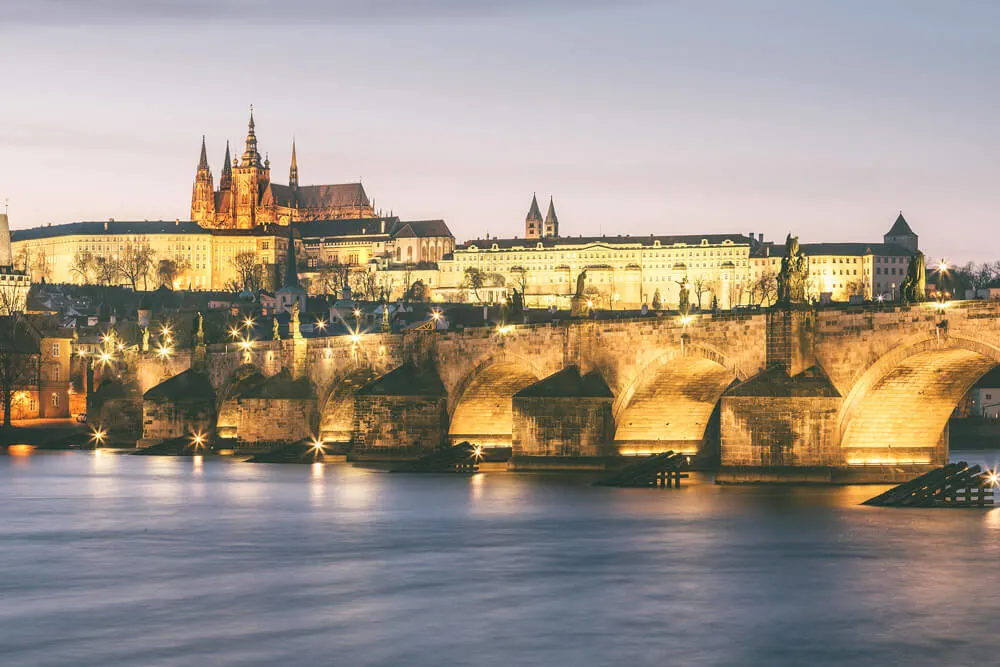
Let’s first cover the practicalities of visiting Prague Castle:
Where is Prague Castle?
Well, the moment a view of Prague opens in front of your eyes, you’ll be clear. The Prague Castle dominates the left bank of the Vltava River. It’s located in Hradčany, i.e. the Castle district.
It’s raised slightly, so you may say it’s located on a Prague Castle hill.
Prague Castle Hours
Prague Castle opening hours differ slightly by the season. Yearround, the Prague Castle complex stays open from 6 am to 10 pm.
The individual historical buildings plus the Golden Lane open at 9 am the whole year-round, and they close at 5 pm in Prague summer season (April 1 until October 31), at 4 pm in Prague winter season (November 1 until March 31).
Prague Castle Tour
The easiest way to visit Prague Castle is on a tour. You won’t have to worry about spending time in line to get your ticket and you’ll have a guide to help you understand the structure of Prague Castle (it’s big!) and tell you about its history.
Skip-the-line Ticket to Prague Castle
This budget-friendly option allows you to explore the castle on your own and buy the Prague Castle tickets in advance.
The website of Prague Castle doesn’t offer online tickets and via GetYourGuide is the only official option to score the tickets in advance and minimize waiting time.
Small Group Tour & an Entrance Ticket
A local guide leads this 3-hour long, highly rated group tour. You’ll meet your guide by the metro stop Malostranská and he/she will take you to the Prague Castle by tram (included in the rate), using an entrance with the shortest security check line. You’ll be given your tickets and won’t need to wait. The guide uses a microphone and headphones, so you’ll hear everything perfectly.
It’s also possible to go for a private guided tour option.
If you’re looking for top Prague tours when visiting the city of a hundred spires, you cannot leave the one covering the castle. It’s a total must!
Official Tours offered by Prague Castle
When it comes to the official Castle Tours in Prague, you can make use of an hourlong group tour led by the local castle guides. It costs 250 CZK ($11 or €10). You can sign up for it at the ticket counter or even in advance.
Please note this option to reserve an official tour led by the guides at Prague Castle is relatively new and may have some hiccups. E.g. as of April 2024, I don’t see an option to book a tour in other language than English and the pricing is all over the place.
There are audioguides available too, each costing 350 CZK ($15 or €14) for 3 hours.
Prague Castle Ticket
You can easily visit on your own, of course. While you can walk around the courtyards and admire the Cathedral and the palaces from the outside for free, the Prague Castle ticket entails you to see Prague Castle inside.
The standard Prague Castle entrance fee (the full “B” circuit) is currently 450 CZK ($19 or €18). The reduced rate (for students until 26 and seniors above 65) is 300 CZK ($13 or €12). There’s also a family admission ticket at 950 CZK ($41 or €38) for a family of two adults and max. 5 children under 16.
The prices increased in March 2024, so if you see a lower pricing elsewhere, that information is outdated.
Actually, there are three info centers, where you can get your tickets – in the first courtyard, in the second one right by the St. Vitus Cathedral, and just before the entrance to the Golden lane.
Nowadays, it’s also possible to buy an official Prague Castle ticket online in advance. However, that option is not so user-friendly, the app is not fully translated to English and the tickets must either be printed out or picked up at a TicketPortal selling point (NOT at the Prague Castle!). If you’re feeling adventurous, you can find the Prague Castle ticket reservation portal here.
The full (“B” circuit) admission entails you to visit the St. Vitus Cathedral, the St. George’s Basilica, the Old Royal Palace, and the Golden Lane with the Daliborka Tower.
The ticket is valid for 2 days, but once you enter each historical building, you cannot re-enter it.
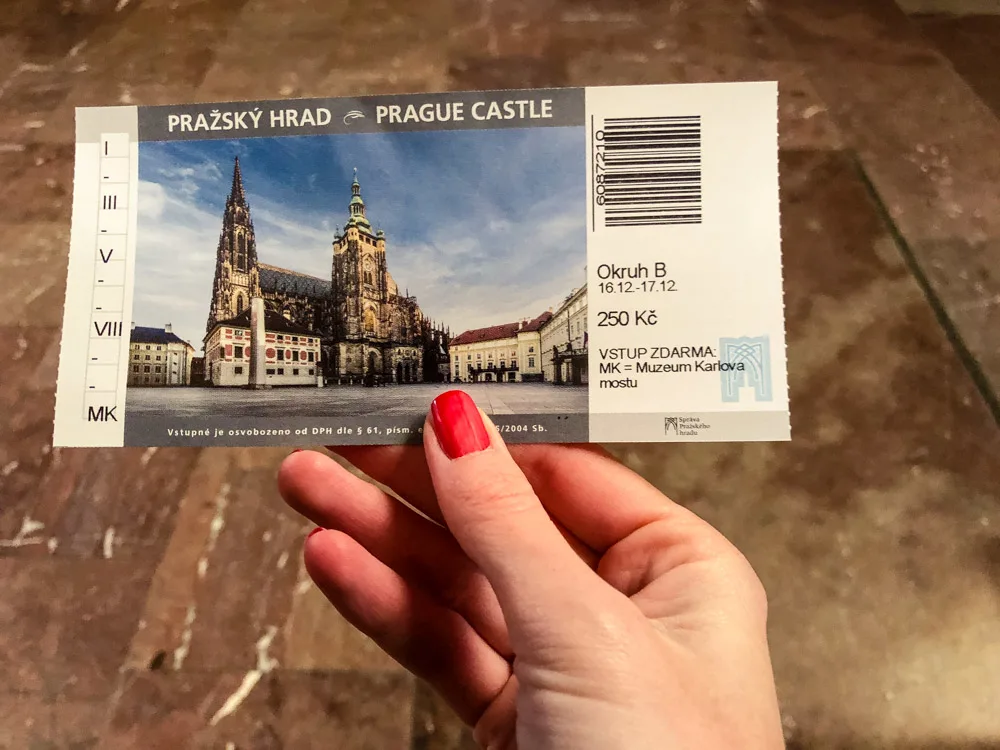
If you wish to visit the Great South Tower of the St. Vitus Cathedral, it costs extra – 200 CZK ($9 or €8). I can highly recommend it!
Hotels Close to Prague Castle
Unfortunately, there’s no such thing as a Prague Castle Hotel. Or if for anyone, it’s the President. If he doesn’t invite you over, you cannot stay within the Prague Castle grounds.
I’ve done the research and would like to recommend some hotels close to Prague Castle as well as a few that are a bit further away but easily walkable or accessible by direct transportation.
In the following list, you’ll find 3 luxury hotels near Prague Castle, 3 mid-range hotels close to Prague Castle, and 3 low-cost options, two of which are easily walkable and a final option which is accessible by an easy tram ride.
The final option, Czech Inn, although it’s the furthest away is actually in the hippest parts of the city, where you can find the best cafés and restaurants and experience life like a local.
| Hotel & Category | Description | More Details |
|---|---|---|
|
Design Hotel Neruda
**** Luxury |
The Design Hotel Neruda is one of the most beautiful hotels near Prague castle. At only 300m away from the castle, you can’t get much closer. The building dates back to the 14th century and the exquisite interior of each room was meticulously designed by the world-famous Czech architect, Borek Sipek. This magnificent hotel also features a spa area including a hot tub and sauna. | Check prices and availability |
|
Lindner Hotel Prague Castle
**** Luxury |
Located in a quiet area next to the Strahov Monastery in a 16th-century building, the Lindner Hotel is one of the most luxurious hotels close to the Prague castle. All rooms are elegantly furnished and air-conditioned. The hotel features a restaurant that serves both Czech and international cuisine and during the summer months, you can enjoy your breakfast on the terrace in their historic courtyard. | Check prices and availability |
|
U Páva
**** Luxury |
This family-run Prague castle hotel is also only 300m away from the castle. It’s a charming hotel that offers excellent views and air-conditioned rooms that are uniquely styled with period furniture and original paintings. | Check prices and availability |
|
Hotel Roma
**** Mid-Range |
Located in the lesser district (Mala Strana) the Hotel Roma is within easy walking distance to the Petrin Tower, the Charles Bridge, and the Prague castle. During your stay at the Hotel Roma, you’ll also have access to a sauna and gym. | Check prices and availability |
|
Three Golden Crowns Apartments
*** Mid-Range |
At 650m away from the castle, this is one of the hotels close to Prague castle whose rooms feature hardwood floors along with a fully equipped kitchen complete with a refrigerator and coffee machine. | Check prices and availability |
|
Hotel U 3 Pštrosů
**** Mid-Range |
Located next to the Charles Bridge in the historical center, U 3 Pstrosu resides in a renaissance building dating back to the 16th century with only 18 rooms and is one of the more unique hotels near the Prague castle. The suite and the Charles IV apartment even feature a spa bath. | Check prices and availability |
|
Hotel Klarinn Prague Castle
**** Low-Cost |
Set in a historic Art Nouveau building, dating back to the late 19th century, Hotel Karlinn is located near the river. Formerly known as Hotel Trinidad Prague Castle, this Prague castle hotel offers luxurious accommodations in the low-cost price range is within easy walking distance of the castle and the Charles Bridge. | Check prices and availability |
|
Prague Dream Hostel
**** Low-Cost |
Located next to the National Museum, this centrally located hostel features a garden and terrace for quiet relaxation in the center of Prague. Although it’s not one of the Prague hotels near the castle, it’s still within comfortable walking distance to the castle and the Old Town Square where you’ll see the famous Astronomical clock. This accommodation offers a hipster vibe and provides a 24-hour front desk, airport transfers, a shared kitchen, and WiFi throughout the premises making it an ideal low-cost choice. | Check prices and availability |
|
Czech Inn
*** Low-Cost |
The Czech Inn is housed in a beautiful 19th-century building in Vinohrady which is the best area of Prague for locals. The surroundings offer the best restaurants and cafes in the city which are all well off the beaten path. It’s not one of the Prague hotels near the castle but there is a direct tram (Tram 22) which takes you there. The tram ride to the castle is a beautiful ride through the city and is an adventurous experience in itself. | Check prices and availability |
Getting to Prague Castle
Let’s now cover how to get to the Prague Castle. It’s relatively easy but since there’s more than one entrance to Prague Castle, it leaves many first-time visitors confused.
The most common option, and the easiest one, is to simply take tram no. 22/23 to a stop called Pražský hrad (meaning Prague Castle) and use its side entrance. You’ll get off, turn left and the road will lead you straight to the entrance.
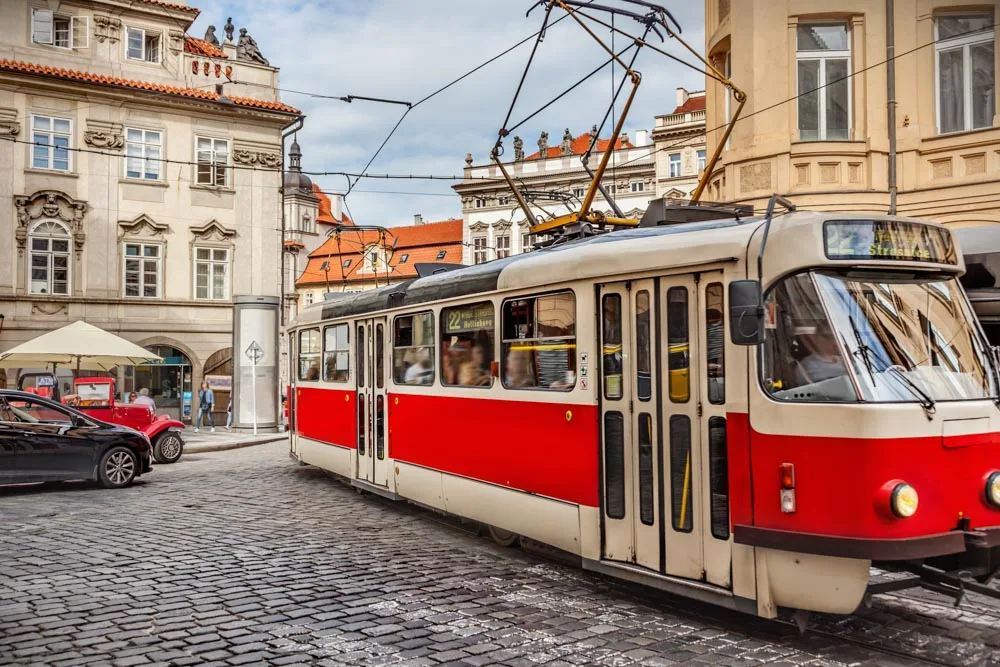
If you don’t mind a bit of walking, even up a hill, you’ll enjoy a stroll from the tram stop Malostranské náměstí (tram no. 12, 15, 20, 22, 23). Then, you’ll simply walk up Nerudova street, admiring the cute houses on the way.
At the road’s end, turn to the right and you’ll find yourself at a beautiful viewpoint right at the edge of the Hradčanské náměstí, the square in front of Prague Castle complex. It’s right there where the front entrance to Prague Castle is.
These are the two best ways to get to Prague Castle. You can also walk up the Old Castle stairs, but it’s typically the best way to exit, so you’ll walk the same path twice.
In summer, it’s also possible to go through the gardens – just get off the tram no. 22/23 at Královský letohrádek.
When to Visit Prague Castle
The Prague Castle can be visited yearround. Each season has its own specifics, though. Summer is the busiest tourist season and so you’re likely to encounter the biggest crowds.
Since introducing the security frames in 2016, long lines often form. First by the frames and then by the ticket center.
Generally speaking, if you can, avoid weekends. Early mornings or late afternoons during the workweek are your best bet for the smallest crowds.
With the practical things of visiting Prague Castle out of the way, let’s dive deeper into the facts of the amazing landmark:
History of Prague Castle
Archeological findings show that the base for today’s Prague Castle comes from the 8th century. In the 9th century, it was basically a fortified settlement enclosed by a moat. From this time comes the Church of the Virgin Mary, whose remnants were found between the second courtyard and the Bastion Garden.
Prague Castle complex saw its main development in the 10th century when it also became the seat of not just the rulers, but also the Prague bishop. The St. George’s Basilica was begun back then as the St. George’s Church.
The 14th century was the time of prosperity thanks to King Charles IV, who made the Prague Castle his residence and, when he became Emperor, also the seat of the Holy Roman Empire. He even had the spires at the Castle covered with gold-plated metal sheets. It’s also when the works on the majestic St. Vitus Cathedral started (in the Gothic style), on the grounds of the modest St. Vitus Basilica from the 10th century.
Charles’s son, Wenceslas IV, further developed the Prague Castle. An abrupt end to the good times for the Castle came with the Hussite wars. The damage done to the castle prevented the subsequent kings from using the Prague Castle as their seat for more than 100 years.
The 15th century turned that over and the new dynasty of Jagellons reconstructed the castle majorly in the Renaissance style, made it their seat, and added some fortifications, such as today’s defense towers the Powder Tower, the New White Tower, and Daliborka.
The Prague Castle spread throughout the 16th century during the Habsburg rule and had gardens and buildings for entertainment purposes built. Especially in the second half of the century, Emperor Rudolph II. turned the Castle into the real center of the Empire, expanded it even further, and brought in invaluable artistic and scientific collections.
Unfortunately, the Prague defenestration at the beginning of the 17th century and the Thirty Years’ War that followed saw the Castle incur significant damage.
Even though in the 18th century, some major rebuilding happened thanks to Empress Maria Theresa, the importance of the Castle vaned since the capital of the Empire was then in Vienna.
The 19th century again brought Emperor, this time Ferdinand V, to the Prague Castle and further renovations ensued. At that time, the grand St. Vitus Cathedral was still far from being finished.
Only the early 20th century saw the finishing of the Cathedral in 1929, almost six centuries after its start. When the independent Czechoslovak Republic was founded in 1918, Prague Castle again became the seat of the head of state.
Ever since, Prague Castle has seen ongoing renovations, depending on funds. The famous Slovenian architect Josip Plecnik helped with some necessary alterations in the 1920s.
As you can see, the Prague Castle was basically a living organism throughout its history of over a thousand years. Base structures gave way to buildings from a style that was current at that time. That’s why you can see Romanesque palaces, Renaissance structures, as well as the mystically Gothic St. Vitus Cathedral.
It’s a beautiful hodgepodge of architectural styles from different centuries. Prague Castle is truly like no other.
When putting together Prague Castle history, I mostly used this official source (and many other sources additionally).
What Makes the Prague Castle?
There are several structures inside Prague Castle. Since it’s one of the largest castle complexes in the world, it may become a bit overwhelming trying to navigate them all.
Well, I’m here to help.
I list them in order, in which they are laid out and in which it makes the most sense to visit them. Often the exit of one place is close to an entrance of the next one. If you want to keep your Prague Castle visit efficient, stick to the order.
St. Vitus Cathedral
Katedrála svatého Víta
This is THE Prague Castle Cathedral and the most visible landmark of the whole Prague Castle.
After following a narrow passage leading to the third courtyard of the castle complex, you’ll experience your first unforgettable glimpse of the immense and awe-inspiring Saint Vitus Cathedral. This view never gets old.
But let’s dive into St. Vitus Cathedral history. Long ago in the year 1344, the great King Charles IV commissioned the construction of what was to become the largest and most important Gothic cathedral in the Czech Republic.
The first master builder assigned to the Saint Vitus Cathedral Prague was a Frenchman, Matthew of Arras, who was summoned from Avignon and began the design of the cathedral in the French Gothic style. However, he lived only long enough to build the foundational aspects of the cathedral.
The second master builder to assume control of the project, in 1352, was 23-year-old Peter Parler (in Czech Petr Parléř), a German-Bohemian architect, and sculptor from the renowned Parler family of master builders. Peter originally worked from the plans left by his predecessor, Matthew, and once all of the unfinished aspects were complete, he continued according to his own ideas.
Matthew was schooled in geometry and put heavy emphasis on rigid systems of proportions and clear, mathematical compositions in his design. Peter on the other hand was trained as a sculptor and woodcarver and treated the cathedral more like a sculpture. His bold and innovative design brought unique elements of Gothic style to the architecture.
Work on the Prague cathedral proceeded slowly as the Emperor had also commissioned Peter to work on a number of other churches in the Czech realm as well as the Charles Bridge. When Peter died in 1397 he was succeeded by his two sons Wenzel and Johannes, who in turn were succeeded by esteemed members of the Parler’s workshop.
In 1914, progress on the cathedral in Prague Castle came to a complete halt for several centuries due to the Hussite Wars. Its construction would eventually span the course of almost 600 years.
During this lengthy period, the uncompleted cathedral was nevertheless in full use for royal masses, funerals, and the coronations of kings and queens. However, it wasn’t until 1929 that the church was fully completed and opened to the public. It now serves not only as a religious center but also as one of the most important fixtures of Czech national heritage.
One of the most outstanding spaces in the cathedral, designed by Peter Parler, is the Saint Wenceslas chapel. The walls of the chapel are beautifully decorated with 1300 Bohemian gems and the wall joints are covered with gold. In the middle of the chapel sits the actual tomb of Saint Wenceslas who you may know from the Christmas carol “Good King Wenceslas”.
In addition to the tomb of Saint Wenceslas, the cathedral houses a royal tomb, located underneath the main altar, for the most influential Czech royal figures including King Charles IV and his four wives, King Rudolph II and King George of Podebrady.
The main tomb inside the St. Vitus Cathedral, on the ground level where the standard tourist route is, is the silver-plated tomb of St. John of Nepomuk.
The St. Vitus Cathedral in Prague also features many large and extraordinarily beautiful stained glass windows, one of which was designed by the famous Czech artist Alphonse Mucha and can be seen on the left side of the third chapel, known as the New Archbishop’s chapel.
Great South Tower
Velká jižní věž katedrály sv. Víta
Unless you’re afraid of heights, no visit to the cathedral would be complete without climbing to the top of the “Great South Tower”. The large, beautiful Prague Castle tower located just to the right of the church rises almost 100 meters and is taller than the cathedral itself.
The construction of the south tower started in the 14th century under the direction of Peter Parler, deviates from the Gothic style of the cathedral and instead follows the Renaissance style. For this reason, it looks noticeably different from the cathedral.
The tower requires that you conquer 287 steps in order to reach the top but your effort will reward you with extraordinary views of Prague which spreads out beneath you.
The South Tower also serves as a bell tower and actually contains the largest bell in the country, weighing about 15 tons. The bell’s name is Zikmund and was cast in 1549. It’s so large that 6 people are required just to ring it, 4 to swing the bell, and 2 to operate the “clapper”.
Old Royal Palace
Starý královský palác
The Old Royal Palace Prague is one of the oldest sections of the Castle. Constructed in the 12th century it was originally occupied by Czech Princes and later became the residence of the King.
The palace continued to serve as the lodging of sovereigns until the 16th century when the Hapsburgs moved their residence to the western part of the castle. From that time forward the palace served royal state purposes.
The great Vladislav Hall, which you’ll enter first, was the location for coronation festivities, balls, banquets, knights’ tournaments, and jousting competitions. Yes, even jousting competitions were held in the 62-meter (203 foot) long hall.
In order to accommodate the horses, one end of the hall features a rider’s staircase where knights entered on horseback. This unique entryway is 3.5 meters (11.5 feet) wide and 9 mild steps provide a gentle incline for the horses to comfortably make their entrance into the hall.
The Vladislav Hall is adorned by remarkable 5-meter-high windows, opulent chandeliers, and wooden floors dating back to the 18th century. State events are still held in the Vladislav Hall, namely the swearing-in of new Czech presidents.
From the Vladislav Hall, there is a portal that leads into the Ludwig Wing which used to serve as the offices of the Czech Chancellery. On the morning of May 23, 1618, during a meeting in the offices of the chancellery, things got out of hand. On this fateful morning, a group of Protestant nobles broke into the chancellery offices and accused the members of disturbing the peace of the Bohemian Kingdom.
During the ensuing pandemonium the insurgents “defenestrated” two Catholic regents and their secretary, meaning they were thrown out of one of the office windows. All three miraculously survived the 21-meter (70 foot) fall from the third story window, but the event sparked the uprising of the Bohemian States against the Hapsburgs which eventually led to the Thirty Years’ War.
The Diet (Assembly) Hall originally served as a space for officials to assemble for the purpose of carrying out government business and resolving legal issues mainly concerning the ownership rights of property and businesses. This grand hall was the seat of the Czech “Supreme court” even during the time of King Charles IV and the room itself has remained the same since his time.
A visit to the Diet Hall today will not only provide you with a giant leap back in time but you’ll also have a chance to see the crown jewels on display. As the real crown jewels are valued at an estimated $4 billion, these artifacts are only replicas that are to be experienced and enjoyed during your visit.
Adjacent to the Diet Hall you’ll find the New Land Rolls Room which was used as a repository for land titles. The unique feature of this space, which makes it a must-see, is the beautiful coats of arms painted on the ceiling and walls, commemorating the families of individuals who held important land offices from the 16th to the 18th century.
St. George’s Basilica
Bazilika svatého Jiří
Founded in 920, Saint George’s Basilica Prague is the oldest surviving church at the Prague castle. Located just behind the Saint Vitus Cathedral, it was a prominent place of worship at the beginning of the spread of Christianity throughout Bohemia. A Gothic chapel located within the church was devoted to Ludmila of Bohemia, the grandmother of Saint Wenceslas who spent most of her days raising the future king.
During a siege in 1142, the church suffered a destructive fire and had to be rebuilt. In the course of the reconstruction two towers were added to the church, the larger one was nicknamed Adam and the smaller one is called Eve.
And, if the 1142 fire wasn’t enough, another fire devastated the poor Basilica in 1541 and it had to be rebuilt again.
In 1671, the beautiful Baroque facade, which remains today, was constructed under the direction of Francisco Carrati. Fortunately, since that time (knock on wood) there have been no further disastrous fires.
Unique to most Baroque churches in Prague, the simple and austere interior of Saint George’s Basilica is made of beautiful limestone blocks. The ceiling is made from dark wood and the decorative windows provide a warm light on its stone walls offering a cozy experience.
A number of important tombs also reside in the ancient Basilica, notably the tomb of Ludmila of Bohemia and Prince Vratislav, who was the son of Ludmila, the father of Saint Wenceslas and the founder of the Basilica in 920.
The Basilica now serves as a temporary concert hall and houses art collections from the National Gallery in Prague (NGP).
This magnificent church, which has remarkably survived the many hardships of wars and plagues, as well as natural disasters, still remains to be an extraordinary historical gem.
Golden Lane Prague
Zlatá ulička
Another must-see in Prague Castle, Golden Lane is a small street and is possibly the most charming and picturesque area in all of Prague. The tiny colorfully painted homes, which adorn this ancient street look as though they were made of gingerbread and could be eaten.
During the 16th century the little homes, made from stone, wood, and mud, were built by the order of Emperor Rudolph II. They were originally to house the castle guards, servants, and goldsmiths from which the street earned the name Goldsmith Lane. The name eventually evolved into Golden Lane as it remains to be today.
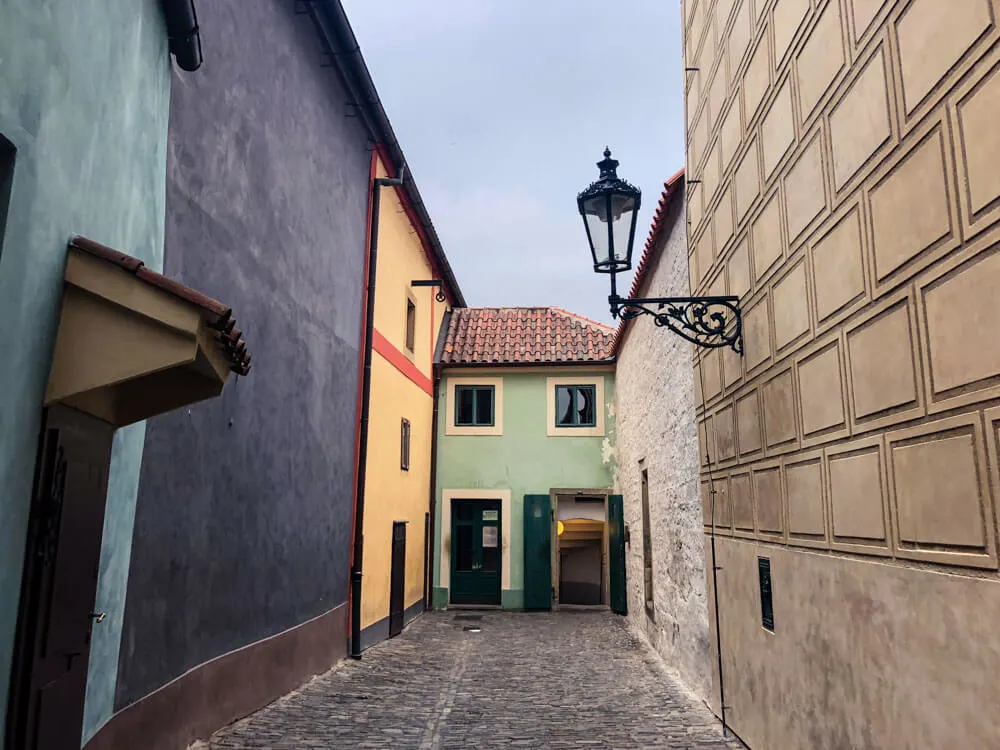
One of Prague’s most famous literary icons, Franz Kafka, lived on Golden Lane with his sister, in house No. 22, from 1916 to 1917. During his year-long stay, he started working on his novel, appropriately named, The Castle.
In the 1950s the houses were painted with the bright colors they are known for today, and integrated into shops and showrooms. They have also been decorated with furniture and artifacts, which represent different eras that will take you on a journey through history.
Also, don’t miss out on checking out the museum of medieval armory – it’s located on the first floor of the fortification running along the Golden Lane. Right when you enter Golden Lane through the standard entrance walking from the direction of St. Vitus Cathedral, you’ll see the entryway in front of you, with stairs leading up. Walk up a few floors to see the museum exhibits and then follow the long corridor lined with armor.
Even if you’re pressed for time when you visit the Castle, Prague Golden Lane deserves at least a stroll!
Daliborka Tower
Daliborka
At the eastern end of Golden Lane, you’ll find a cylindrical tower, called the Daliborka Tower, which famously served as a prison.
Its original purpose is said to have been for housing artillery within its thick walls and it later evolved into a prison for the royal class.
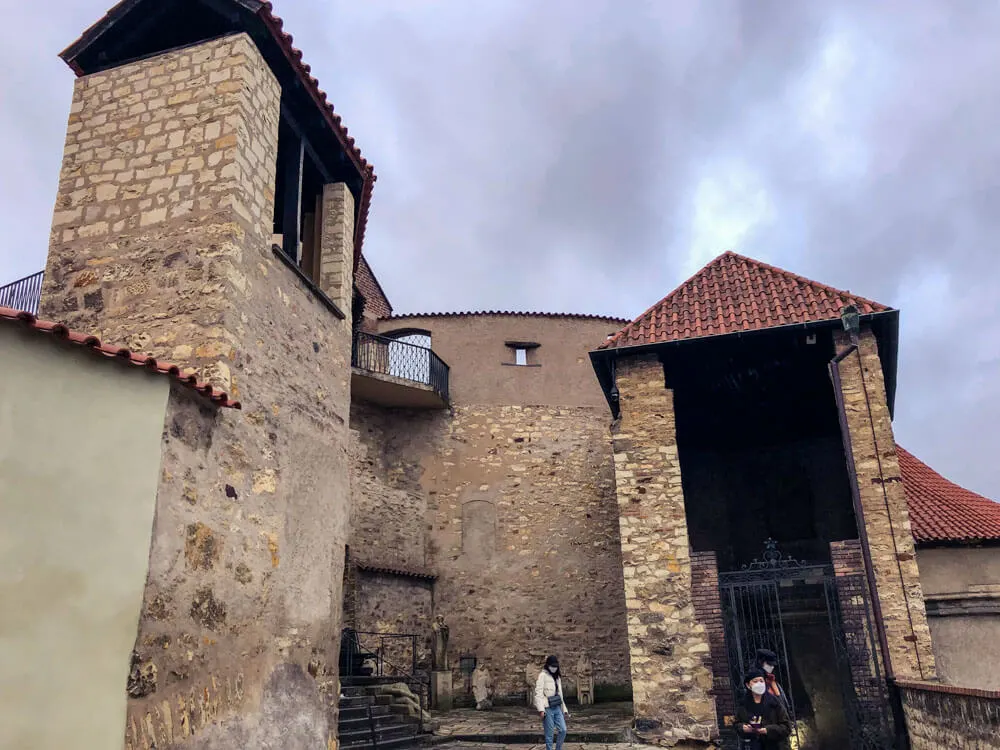
According to legend, the first prisoner of the tower was a knight named Dalibor who was sentenced to imprisonment and death, in 1496, for the crime of sheltering rebellious peasants during an uprising.
As the famous legend goes, Dalibor learned to play the violin while being held in the tower. The beautiful music that he produced was heard from afar and attracted audiences who took pity on poor Dalibor and gave him food and drink.
The Czech composer, Bedřich Smetana, even wrote an opera based on the famous legend titled “Dalibor” which was first performed at the National Theatre of Prague in 1868.
However, a more realistic and dark theory is that the legend originated from the use of a torture device called the Violin and that the “music” which could be heard far and wide, was from poor Dalibor’s screams.
But that’s not all when it comes to the buildings of Prague Castle:
Lobkowicz Palace Prague
Constructed in the second half of the 16th century, the Lobkowicz Palace at Prague Castle is the only part of the castle complex that is privately owned.
Opened to the public for the first time in 2007 as the Lobkowicz Palace Museum, it contains a large collection of artwork, military and hunting paraphernalia, musical instruments, and original manuscripts from composers such as Beethoven and Mozart. The collections on display at the Lobkowicz palace are one of Europe’s oldest and finest private collections, including pieces dating back over 2,000 years.
The Lobkowicz collections were confiscated during the Nazi and Communist regimes. After the Velvet Revolution President Václav Havel enacted a series of laws that allowed for the restitution of confiscated properties and during the 1990s the priceless collections were reclaimed by the Lobkowicz family who made these previously hidden treasures available to the public for the first time in history.
To get into the Lobkowicz Palace, you need to buy a ticket:
- either a standalone one, just for the Lobkowicz Palace
- or a combined ticket for the Prague Castle AND the Lobkowicz Palace
The Lobkowicz Palace Museum also features a Baroque concert hall which serves as a venue for classical performances underneath its 17th-century frescoed ceiling. You can experience the splendor of the Concert Hall by attending one of its classical concerts which are often held at midday.
In addition, there is a Lobkowicz Palace Café and a Restaurant located on the ground floor which provides panoramic views of Prague to enjoy while relaxing with a snack. A gift shop is also available.
Prague Castle Gardens
What would a castle be without gardens, right? Prague Castle gardens surround the whole complex and are beautifully diverse. They are free to visit.
If you visit Prague in spring, summer, or fall, you shouldn’t leave them out from your trip!
Prague Castle gardens opening hours are from 10 am to 6 pm in the summer season lasting from the beginning of April until the end of October. For the remainder of the year, the gardens are closed.
The South Gardens
Jižní zahrady
These are the gardens below Prague Castle and, in my opinion, the most interesting ones. They were at their best during the times of president T. G. Masaryk, who had the famous Slovenian architect Plečnik get involved in the design and architecture. Since 2012, the South gardens were restored to their former beauty.
The South Gardens are made up of three gardens, of which two you can visit. The Rampart Garden runs along the ramparts and offers stunning views of Prague. This is the part of the South Gardens of Prague Castle that you’ll mostly peruse.
Then there’s the Paradise Garden marked by a giant granite bowl on a lawn and a big staircase. The third part of the South Gardens, the Hartig Garden, is not accessible to the public.
You can enter the garden below Prague Castle via two entrances. Either at the top of the Old Castle Stairs near the eastern gate – so you’d visit the gardens after walking through the Prague Castle complex, past the Golden Lane and Daliborka Tower, and then turning right towards the garden, just before the security frames.
Another entrance right into the middle of the garden is hidden next to the Old Royal Palace, on the third Courtyard via the so-called Bull Staircase. When you stand with your back to the Great South Tower of the St. Vitus Cathedral, the staircase’s entrance will be across the courtyard from you.
Royal Garden
Královská zahrada
The Royal Garden of Prague Castle can be found on the other side of the castle than where the South Gardens are. The garden was built on a former vineyard in Renaissance style. Nowadays, it follows the English garden style but there are still enough Renaissance features throughout. The Old Summer Palace on its end is especially picturesque and photogenic.
On the other side, you’ll pass by the beautiful Ball Game Hall, where events often take place.
You can access the Prague Castle Royal Garden from the tram stop “Královský Letohrádek” using the northern gate to the Prague Castle grounds – just one stop before the “Pražský hrad” stop. Another option is to use the entrance on the “U Prašného mostu” Street right by the actual castle.
Stag Moat
Jelení příkop
If you prefer rather wild gardens to perfectly manicured ones, you’ll love the stag moat. It’s just a small valley with a stream. Deer used to live here in the 17th and 18th centuries, thus the name. From 1919 until the 60s, bears gifted from Siberia during the T. G. Masaryk era lived in the moat.
Btw. there are two parts of the stag moat – upper and lower one – connected with a short tunnel. The lower one has been closed for a while due to renovation works.
In the upper moat, the path will eventually lead you up the hill to the right to Masaryk’s viewpoint. It’s a nice place but don’t expect much of a view because of the trees around.
You can access the stag moat from the “U Prašného mostu” Street by the castle.
I hope this deep overview of visiting Prague Castle has helped you in planning your own trip and visit to the most amazing of Czech castles. If you didn’t find an answer to anything, please do let me know below in the comments and I’ll get back to you shortly.

